-
June 14, 2010 - COMMENTARY
Yesterday, I had the thrill of playing the National Anthem with members of the Boston Pops and the Tanglewood Festival Chorus (conducted by James Orent)at Game 5 of the National Basketball Association Finals game 5 between the Boston Celtics
and the Los Angeles Lakers, held in the TD Garden in Boston.
In my career as a member of the Boston Symphony, I have done this at many high-level sporting events, including Game 2 of the 2008 NBA FInals and
Superbowl XXXVI (when the New England Patriots defeated the Saint Louis Rams). It is always a special thrill. The game was won by the Celtics, 92-86, and to be in a private
box with several colleagues as well as former Celtics Bill Walton and coach K.C. Jones was a rare and special thing. Below is a selection of photos from the game that show, among other things, the trombone players
at the Garden (Ronald Barron, Hans Bohn and myself), Celtic Ray Allen practicing free throws before the game (which he did for an hour), the view of the action from my seat, and me with Bill Walton (he is a giant among men -
I am six feet tall - and he is one of the nicest people I have ever met - and a former trombone player as well) and former Celtics coach K.C. Jones. A video of the performance has been posted on YouTube - click below to play it.


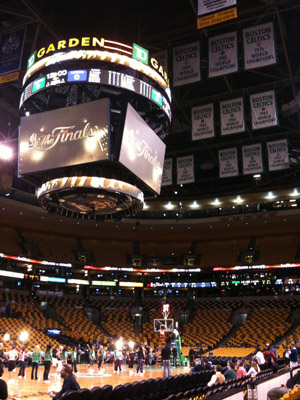
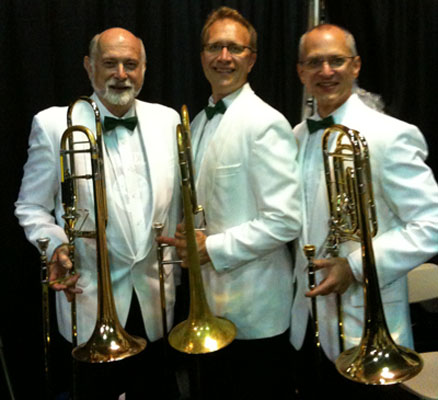




-
May 24, 2010 - NEW
On May 22, I was privileged to take part in a memorial service for my friend, trombonist Bill Pearce (see my entry for February 25, below). In additional to playing some of Bill's
arrangements for trombone and piano, I was asked to give the Homily at the service, which I titled, To God Be The Glory: Bill Pearce and Musical Excellence.
To read my Homily, and see some photos of the memorial service and Bill Pearce, click
HERE.
-
May 15, 2010 - NEW
On May 2, I was inducted into the Hewlett-Woodmere Alumni Association Hall of Fame, in a ceremony at George W. Hewlett HIgh School (Hewlett, New York). This was a wonderful time of
remembering my 11 years of living in Valley Stream, New York and my attending elementary, junior high, and high school in Hewlett. To read the comments I gave after my induction,
and view some photographs of me in the influential years of 1960-1971, click
HERE.
-
April 25, 2010 - NEW
A memorial service/tribute for trombonist Bill Pearce (see the "What's New" entry below, for February 25, 2010) will be held on May 22 at Moody Bible Institute in Chicago. I've been asked to take part
in the event and have added a page on my website with details about the service. To go to this page, click
HERE.
-
February 25, 2010 - COMMENTARY
 On Monday evening, February 22, my friend, trombonist Bill Pearce, passed from this life to the next. He was 83 years old; his death came after a long battle
with Parkinson's Disease.
On Monday evening, February 22, my friend, trombonist Bill Pearce, passed from this life to the next. He was 83 years old; his death came after a long battle
with Parkinson's Disease.
I first met Bill Pearce in 1974 while a student at
Wheaton College.
My friend, Jim Roskam, was playing an LP of Bill's down the hall from my dormitory room and I was
astounded with his tremendous trombone artistry. Of course Bill was far more than a trombone player - he was a pioneer of Christian radio
broadcasting, and a gifted vocalist who sang in a duet team with Dick Anthony. He was also a member of the Melody Four Quartet and the Sixteen Singing Men.
His radio program
Nightsounds
is heard around the world with Bill's unique blend of music and commentary.
 Earlier today, I was interviewed for the radio program Prime Time America, produced by WMBI Radio, the radio station of Moody Bible Institute in Chicago
where Bill got his start in broadcasting. I was honored to be asked to say a few words in tribute to Bill, along with Dick Anthony and George Beverly Shea (who is
101 years old and worked alongside Bill in many vocal groups). If you have
a chance to listen to this program, I am sure you will be moved, as was I, by George Beverly Shea's account of Bill's final moments before he died. You can hear the
program (archived on the Moody Radio website) in the first hour of the
Moody Radio Prime Time America on February 25, 2010.
Earlier today, I was interviewed for the radio program Prime Time America, produced by WMBI Radio, the radio station of Moody Bible Institute in Chicago
where Bill got his start in broadcasting. I was honored to be asked to say a few words in tribute to Bill, along with Dick Anthony and George Beverly Shea (who is
101 years old and worked alongside Bill in many vocal groups). If you have
a chance to listen to this program, I am sure you will be moved, as was I, by George Beverly Shea's account of Bill's final moments before he died. You can hear the
program (archived on the Moody Radio website) in the first hour of the
Moody Radio Prime Time America on February 25, 2010.
It is impossible for me to sum up Bill's influence on me. Along with Edward Kleinhammer and George Roberts, Bill Pearce is one of my greatest
trombone role-models. His sense of phrasing and legato - and the beauty of his articulation - are things I have worked to emulate for all of my
professional life. Bill was also a person of great humility and kindness. His willingness to narrate passages from the Bible on my CD
Cornerstone
is indicative of how Bill did things. To say his voice added measurably to the album is a profound understatment. I am just so pleased
that even though he is now gone from this earth, his voice, trombone playing and legacy continue.
 In 1998,
I interviewed Bill for an article for the Online Trombone Journal
(photo at left).
That interview has been read countless times, and each reader has gotten to see Bill
talk about the trombone, his work in radio, and his Christian faith. He was also very open about his struggles with Parkinson's Disease which had then
just recently been diagnosed. Over the years, I kept in touch with Bill. He rarely complained about his condition; instead, he always wanted to talk about the trombone,
about trombone players and to find out how I was doing. He rarely allowed the conversation to turn to himself.
In 1998,
I interviewed Bill for an article for the Online Trombone Journal
(photo at left).
That interview has been read countless times, and each reader has gotten to see Bill
talk about the trombone, his work in radio, and his Christian faith. He was also very open about his struggles with Parkinson's Disease which had then
just recently been diagnosed. Over the years, I kept in touch with Bill. He rarely complained about his condition; instead, he always wanted to talk about the trombone,
about trombone players and to find out how I was doing. He rarely allowed the conversation to turn to himself.
When the interview went online, I invited readers who wanted to send Bill a note or card of appreciation to send it to me and I would then forward
it - unopened - to Bill. Over the years, many people did this, and Bill often talked of how he was so greatly encouraged by those messages. He was not
able to reply to them due to the Parkinson's Disease, but they meant so much to him. Those of you who are reading this should know what an
encouragement you were to Bill.
If you have a chance, visit the
Nightsounds website
and order one of Bill's many trombone recordings. His "Touch of Gold" anthology is a convenient way to sample Bill's
trombone playing over a nearly 50 year span. You will not fail to be impressed - not only by his unique kind of trombone artistry, but by the man who meant so much
to so many, including me.
-
January 15, 2010 - NEW
I have added a new article,
Wir bin Ich: Meaning and Self for the Artistic Christian that I first gave as a lecture at the
Lee University School of Music Performance Seminar at Lee University, Cleveland, Tennessee, in April of last year. In it, I speak about the challenge of living
authentically in a post-modern world.
-
January 1, 2010 - COMMENTARY
 The calendar has turned to a new decade, bringing with it many thoughts of the 10 years just past. The world has changed in that time, but before I comment on a significant decade, it is
January 1 that is first on my mind.
The calendar has turned to a new decade, bringing with it many thoughts of the 10 years just past. The world has changed in that time, but before I comment on a significant decade, it is
January 1 that is first on my mind.
In our house, we always tune in the Tournament of Roses Parade, held annually in Pasadena, California. The beautiful, colorful floats - that must be covered entirely with natural flowers and vegetation -
are certainly a focus of attention. But for us, it is the bands that bring us back year after year. Because in 1973, I marched in the Tournament of Roses Parade - a memorable experience that
gave me my first taste of significant travel as a member of a musical organization.
In 1972, shortly after I began my senior year in high school, I was chosen for the McDonald's All-American Band. This band, put together for several years by the McDonald's Corporation, selected
two high school students from each state and one from the District of Columbia to form a 101 piece marching band. The band marched in two parades: the Macy's Thanksgiving Parade in New York City
(November 23, 1972) and the Tournament of Roses parade, always held on January 1. I was a senior at Jefferson Township High School in Oak Ridge, New Jersey, having moved to New Jersey from Valley
Stream, New York, in the summer of 1971. That same fall, I was selected to be principal trombonist of the New Jersey All-State Orchestra and bass trombonist of All-Eastern Orchestra (which met
in January 1973 in Boston - my first trip to what was, many years later, to become my home town). My fellow member from new Jersey in the McDonald's All-American Band was Jeffrey Venho fro Glen Rock,
New Jersey (Jeff has been principal trumpet in New Jersey All-State Orchestra that year).
The trip to California with the McDonald's Band was a thrill; I shall never forget the feeling I had when I stepped to curbside at Los Angeles International Airport and saw a live palm tree for
the first time in my life. From there it was to the campus of UCLA where we rehearsed, and then finally to Pasadena on January 1 to march in the great parade. The photo above shows me (far right)
with Jeff Venho, Betty White (grand marshall of the Parade), conductor Paul Lavalle (who at the time was music director at Radio City Music Hall in New York City) and Sally Noren, the Rose Queen.
 The day dawned with beautiful weather and the parade was a blur of memories. The crowd was enormous, the parade route very long, and the sense of "moment" very strong. In the photo at right, I
can be found in the front rank of the band, third from the left, marching along the double line. January 1, 1973 - a big day in a decade long past, but a day that each year brings back strong
and wonderful memories.
The day dawned with beautiful weather and the parade was a blur of memories. The crowd was enormous, the parade route very long, and the sense of "moment" very strong. In the photo at right, I
can be found in the front rank of the band, third from the left, marching along the double line. January 1, 1973 - a big day in a decade long past, but a day that each year brings back strong
and wonderful memories.
The decade we have just completed - what WILL we call it - the "zeroes" - the "Ohhh's" - the "Oughts"?? - was full of events that are unforgettable. Surely the most memorable were the terrorist
attacks of September 11, 2001. A day doesn't go by without some reminder of that terrible day and its effects are still with us, nearly 10 years later. Yet time moves on. In my own life,
there have been many memorable personal experiences in the last 10 years, many of which are documented on this page. I do not know what the future holds, but I do know that God will lead in the
life of me and my family, and I consider myself a very blessed man to have a wonderful, faithful wife of nearly 35 years at my side with whom to walk side-by-side into what awaits. Happy new year,
friends. On to the 10s.
-
December 22, 2009 - NEW
I have added several additional works by Daniel Chester French to my online gallery of images of his sculpture,
Daniel Chester French: Sculpture in Situ.
Newly added are French's "Head of Victory" (First Division Memorial), "Thomas Starr King," "Wendell Phillips, " and "James Hooker." I have also added new photos and commentary of three
of French's other works, "Mourning Victory," "The Angel of Death and the Sculptor" and "Memory." These additions make a total of 30 of French's scuptures that appear in this ongoing and
growing resource.
-
December 16, 2009 - COMMENTARY
As I mentioned in my
sabbatical diary entry for May 14, 2009 I am in my 25th season as bass trombonist of the Boston Symphony Orchestra which, by extension,
means this is my 25th season with the
Boston Pops Orchestra as well. At this time of year, we are deep into our annual schedule of "Holiday Pops" concerts,
and this time of year brings back many memories of past years of such concerts. There have been changes to be sure but at their heart, these concerts bring a lot of enjoyment to
thousands of people each year. This season, the Pops has commissioned a special telling of the Christmas story with narration from Scripture, a vocal solist and chorus that has special
meaning for me and many in our audiences.
My daughter, Robin, recently sent me a link to a YouTube video that was filmed during my first season in Boston, 1985. It shows John Williams leading the Boston Pops Orchestra in Leroy Anderson's
classic, "Sleigh Ride." Watching this video brought back so many memories of colleages now long gone, and of a time when the pace of concerts was more relaxed.
Perhaps you, too, might enjoy this trip down memory lane. For those interested, the brass section
includes: Norman Bolter, Larry Isaacson, myself (trombones), Chester Schmitz (tuba), Charles Daval, Peter Chapman, Andre Come, Bruce Hall (trumpets), and Richard Sebring, Daniel Katzen,
Jonathan Menkis and Richard Mackey (horn). Click on the image below and enjoy it yourself. Merry Christmas!
-
December 11, 2009 - NEW
I have added a new section to my website,
Resources for young players. My oldest daughter, Linda, is a private low brass instructor in the Chicago area. Over the years,
she has developed a number of resources to help her students; with a studio that has as many as 40 students taking lessons each week, she has a broad experience with young players
from elementary through high school. I thought Linda's resources might be helpful to others, so together we have developed a new area on my website devoted to resources for young players.
Included are many of Linda's handouts and masterclass summaries along with links to other resources for young players that already appear on my website and on external sites. Linda has
also put together some resources for teachers of young players that might be helpful to those who have or are considering starting a teaching studio. I am very proud of Linda and her
work with her students - many of whom place well in Illinois school auditions and go on to be music majors in colleges and universities - and am happy to have her resources in this
new are on my website.
-
October 30, 2009 - COMMENTARY
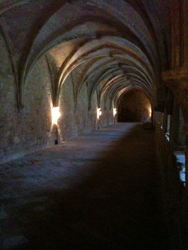 Last week, I attended the 30th Symposium on Musical Instrument Making: The Cornett - History, Instruments and Construction, held at Kloster Michaelstein, Germany. This Symposium
offered me a time of tremendous satisfaction as I continue to explore early music - in particular my interest in the serpent.
Last week, I attended the 30th Symposium on Musical Instrument Making: The Cornett - History, Instruments and Construction, held at Kloster Michaelstein, Germany. This Symposium
offered me a time of tremendous satisfaction as I continue to explore early music - in particular my interest in the serpent.
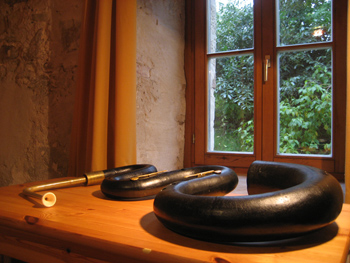 The Symposium was devoted to the cornett - also called the cornetto or, in German, zink. The cornett (not to be confused with the brasswind instrument that is a cousin of the trumpet)
is one of the most beautiful sounding instruments in the world. As the serpent has often been considered part of the cornett family (although there are significant differences
between the two instruments), the serpent was grandfathered into the Symposium. This was a happy decision for serpent players and it is what allowed me to take part in the
Symposium in some particular ways.
The Symposium was devoted to the cornett - also called the cornetto or, in German, zink. The cornett (not to be confused with the brasswind instrument that is a cousin of the trumpet)
is one of the most beautiful sounding instruments in the world. As the serpent has often been considered part of the cornett family (although there are significant differences
between the two instruments), the serpent was grandfathered into the Symposium. This was a happy decision for serpent players and it is what allowed me to take part in the
Symposium in some particular ways.
After an overnight flight from Boston to Frankfurt, I took a train to Hanover where I was met and driven to Michaelstein. Stiftung Kloster Michaelstein has taken over a 12th
century monastery that houses their institute for the study of musical instruments. It is a stunning facility, with a medieval cloister (see the photo above, left), a Rococco chapel (built after the monastery was
dissolved and converted into a school), and many other buildings with three foot thick walls. To be in such buildings is to be transported back to an earlier time - a time without
heat in every room, with windows that were Roman or Gothic arches, and a feeling of a different pace to life. My room was simple but well appointed (photo above, right), and I was
inspired by practicing in a room that was centuries old.
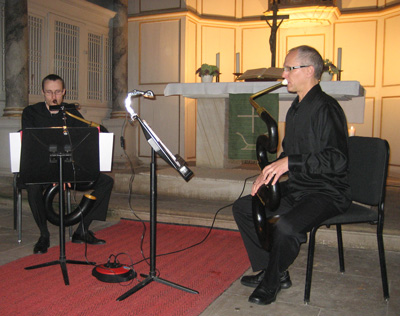 Over 40 scholars gathered for the Symposium and papers were presented on a great many topics. The serpent was well represented not only by me, but by the fine French serpent player,
Volny Hostiou.
While I had known of Volny's playing for several years, we had never met, and Symposium organizer Monika Lustig asked if the two of us would give a recital of duets
for serpent. Volny and I agreed, and when we both arrived in Michaelstein, we found we had an immediate connection that made preparing the recital great fun. The small chapel where we gave the recital was
unheated - my guess is it was about 55 degrees inside at the time we gave our recital (photo at left). Yet it was the perfect location, one that made us and all those who filled the chapel recall
a past time when heat could not be taken for granted. Our program contained music from the 16th to 20th centuries. For many who were present, it was the first time they had ever
heard the serpent and judging from the generous applause and later comments, it seemed we made a positive impression and helped to further the positive reputation of the serpent.
Over 40 scholars gathered for the Symposium and papers were presented on a great many topics. The serpent was well represented not only by me, but by the fine French serpent player,
Volny Hostiou.
While I had known of Volny's playing for several years, we had never met, and Symposium organizer Monika Lustig asked if the two of us would give a recital of duets
for serpent. Volny and I agreed, and when we both arrived in Michaelstein, we found we had an immediate connection that made preparing the recital great fun. The small chapel where we gave the recital was
unheated - my guess is it was about 55 degrees inside at the time we gave our recital (photo at left). Yet it was the perfect location, one that made us and all those who filled the chapel recall
a past time when heat could not be taken for granted. Our program contained music from the 16th to 20th centuries. For many who were present, it was the first time they had ever
heard the serpent and judging from the generous applause and later comments, it seemed we made a positive impression and helped to further the positive reputation of the serpent.
The presentation of papers by scholars was the main part of each day. For my topic, I chose a subject that has been of great interest to me, "Marches and Divertimenti: Haydn and the
Serpent." 2009 is the 200th anniversary of Joseph Haydn's death, so with this topic, I hoped to add something to both the serpent and Haydn literatures. Haydn's writing for serpent - in
three Divertimenti for winds that are attributed to him and in four marches for English military bands - is superb. I collected all of the existing manuscripts of these pieces and
prepared a Powerpoint presentation of the scores along with images of serpents, iconography from the British Museum, and audio recordings of the works I discussed that were made by
several of my Boston Symphony Orchestra colleagues who joined my playing serpent. I was very gratified by the tremendous and generous response of those present and since I have arrived
home, I have been working to put the finishing touches on what will be the print version of my paper that will be published in a book of the Symposium's proceedings sometime next year.
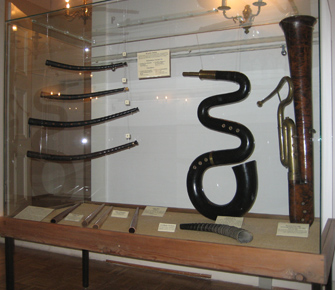 There was also a fine exhibition of musical instruments that had been assembled for the Symposium, focusing on the cornett and serpent (shown at right). The serpent
in the display case is a fine example of
an early military serpent (possibly German in origin, c. early 19th century) that has some significance to my paper and my search for the earliest English military serpent. The
serpent Forveille (shown at far right in the cabinet) is a form of upright serpent that I also played and demonstrated on my upcoming serpent DVD project (for more on that, see my
sabbatical diary entry for June 10, 2009). The exhibition was a great way to bring more tangible reminders of what we were studing to
the participants. For me, music is always to be played, and bringing more instruments to us allowed all who were gathered to bring the music alive off the page.
There was also a fine exhibition of musical instruments that had been assembled for the Symposium, focusing on the cornett and serpent (shown at right). The serpent
in the display case is a fine example of
an early military serpent (possibly German in origin, c. early 19th century) that has some significance to my paper and my search for the earliest English military serpent. The
serpent Forveille (shown at far right in the cabinet) is a form of upright serpent that I also played and demonstrated on my upcoming serpent DVD project (for more on that, see my
sabbatical diary entry for June 10, 2009). The exhibition was a great way to bring more tangible reminders of what we were studing to
the participants. For me, music is always to be played, and bringing more instruments to us allowed all who were gathered to bring the music alive off the page.
In addition, there was a vigorous "round table" discussion on the subject of the bass cornett, an instrument that scholars are certain existed but whose use is really not
completely known. As I had played one of three bass cornetts that have been made in modern times (once again, see my
sabbatical diary entry for June 10, 2009 for a photo of me with a bass cornett), I was asked to take part in the discussion. It was fascinating
to say the least.
I left Michaelstein exhilirated and energized, with many questions answered and many new trails down which to walk. My new friendship with Volny Hostiou will, I am confident, lead
to future collaborations. Already an International event devoted to the serpent is being planned for Paris in 2011 - I will be there, for sure. As I continue to explore early music,
I find the lens through which I view my trombone playing with the Boston Symphony changing in ways big and small. Next week, the Boston Symphony will be playing Beethoven's great
Symphony 9 and in those performances, I will be playing a German bass trombone made in the 1920s by Kruspe. Playing these old trombones - which represent the zenith of
German trombone making - adds a different kind of sound to our trombone section and to the BSO. It is a sound that has captivated every conductor who has heard them. I feel
very fortunate to be in a trombone section that appreciates the value of the old as we push forward into the future. My experience in Michaelstein is just another in my musical
journey that has given me much to consider and which is leading me into new ways of thinking and performing.
-
August 28, 2009 - NEW
I have added photos of Daniel Chester French's stunning sculpture, "The St. Paul's School War Memorial" ("Death and Youth"), to my resource,
Daniel Chester French: Sculpture in Situ.
-
August 17, 2009 - COMMENTARY
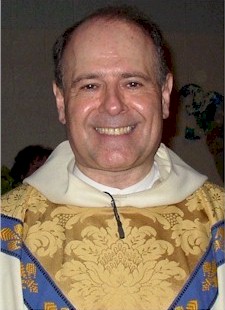 Today my friend, Rev. Michael Alliegro, passed from this world to the next.
Today my friend, Rev. Michael Alliegro, passed from this world to the next.
In 1979, I interviewed for the position of Director of Bands at St. Thomas Aquinas High School in Edison, New Jersey. The advertisement in The New York
Times said to reply to "Father Alliegro." Misreading the name, I assumed that "Father Allegro" was a code name for the music position at the school. It wasn't
until I arrived for my interview that I realized that Father Alliegro was not only truly a person, but he was a person who would have a significant impact on my life.
I was hired for the position at STA (now Bishop Ahr High School) and knew I had work to do. I am certain there were better qualified candidates than I that were
passed over. But there was something about how Father Alliegro and I interacted that was more than that of employer and employee. Eight years my senior, he was
still a young man at the time, and he had his hands full administering a high school. My hands were full, too, leading the concert band, marching band and
beginner band, teaching music theory and a class titled, "Bach to Rock," conducting the school musicals and scoring half time shows. The pay was low and the
work was hard, but with the support of of "Father Mike", I pushed forward and did my best.
Michael Alliegro was a kind man who was intelligent and wise beyond his years. His confidence in me bouyed me and helped me shepherd my students to be not
only better players but better people as well.
The highlight of my two year tenure at St. Thomas Aquinas High School came early in my tenure, when our band was selected to perform at Pope John Paul II's
visit to Battery Park, New York in October 1979. I wrote about this in my "What's New?" entry for April 2, 2005, below. It was a big moment for our school
and its students, and Father Mike and I often talked about the special significance of the event for all of us.
I left STA in June 1981 after the school's annual graduation ceremony was over. I had won the position of bass trombonist in the Baltimore Symphony and I was
leaving for Baltimore the next day. After graduation, I cleaned up (I am convinced that half the life of a high school band director is spent "cleaning up"),
locked up the band room and went to the main office to turn in my not inconsiderable ring of school keys. I saw Father Mike at the end of the hallway and
after getting his attention, I sent my keys down the hall as if they were a bowling ball. They came to rest at Father Mike's feet. "God bless you, friend," he said.
And I was on my way.
We kept in touch from time to time, and several years ago I learned he was dealing with cancer. Last October, my wife and I had dinner with him and Dr. Glenn
Fortin, one of my former students at STA all those years ago (Glenn was a flute player and is now a pediatrician) in New York City, before a Boston Symphony
Concert in Carnegie Hall. Our dinner was a very special time, and I took the opportunity to thank Father Mike for his confidence in me, for his giving me a
chance at my first full time music job. He was gracious but I could tell that he was very happy for and proud of me. A piece of him went with me from STA on to
Baltimore and then to Boston. It was the last time I saw him.
Later this week I will drive to his funeral at the Cathedral of St. Francis of Assisi in Metuchen, New Jersey. Rev. Monsignor Michael J. Alliegro will be laid
to rest. I am a better person for having known this Godly man and man of God. Requiem aeternam dona ei, Domine.
-
August 5, 2009 - NEW
 I began working with the YAMAHA Corporation on the development of a new bass trombone in 1986. By 1992, our collaboration had gotten to the point where the YBL-622
bass trombone was released, and in 2007, the instrument was relaunched - with significant improvements - as the YBL-822G. My relationship with Yamaha has been
a very fruitful one, and also has included the development and marketing of the Douglas Yeo Signature Series Bass Trombone Mouthpiece.
I began working with the YAMAHA Corporation on the development of a new bass trombone in 1986. By 1992, our collaboration had gotten to the point where the YBL-622
bass trombone was released, and in 2007, the instrument was relaunched - with significant improvements - as the YBL-822G. My relationship with Yamaha has been
a very fruitful one, and also has included the development and marketing of the Douglas Yeo Signature Series Bass Trombone Mouthpiece.
Several months ago, I was asked to help in the development of the trombone area of a new Yamaha website titled,
MEET THE BAND.
This site is designed for beginners to learn more about the instruments of the band, to get some information about the instruments, view a short instructional
video, and get advice from notable professional players. I was very pleased to be asked to help put together the trombone area of
MEET THE BAND
and today, the trombone section of the website was launched. I hope you will enjoy this new resource and that you will pass it on to others who might find it to be
helpful. Click
HERE
to go to
MEET THE BAND.
Once there, click on the musical note icon above the word "trombone" and you'll be on your way.
-
July 20, 2009 - COMMENTARY
 This past weekend, I attended the 25th annual Early Brass Festival, hosted by the
Historic Brass Society.
Held on the campus of Connecticut College in
New London, Connecticut, the EBF is held at the middle weekend of the two week long annual Amherst Early Music Festival. These gatherings bring together players on a
host of early instruments and are always informative, convivial gatherings of like-minded people who share an interest in early music.
This past weekend, I attended the 25th annual Early Brass Festival, hosted by the
Historic Brass Society.
Held on the campus of Connecticut College in
New London, Connecticut, the EBF is held at the middle weekend of the two week long annual Amherst Early Music Festival. These gatherings bring together players on a
host of early instruments and are always informative, convivial gatherings of like-minded people who share an interest in early music.
Readers of my website know of my long time love of early bass brass instruments - in particular the serpent and ophicleide - and the Early Brass Festival
afforded me an opportunity to engage in performance on both of those instruments.
Several years ago, my good friend, Craig Kridel, founded
Berlioz Historical Brass,
a collective of players who share a love for early brasses. Through BHB,
we have engaged in a number of performances and scholarly explorations as we continue to work to understand the sound and role of these instruments.
At this year's Early Brass Festival, I took part in two events. The first was a lecture/demonstration on the bass cornetto. This instrument is a curiosity in
the early brass family and there has been virtually no significant research into its shape, size and sound. Craig commissioned a modern reproduction of a
bass cornetto from the maker Roland Wilson (a photo may be seen on my
sabbatical diary
entry for June 10, 2009). Craig and I demonstrated both the serpent and the bass cornetto, and then engaged in a discussion of what the sound of the bass cornetto
might have been liked by using a variety of mouthpieces on the instrument. The purpose of this presentation was to, in a sense, toss a match into the discussion
about this instrument and see what might come of it. Already there is new discussion about the bass cornetto and we look forward to continued explorations.
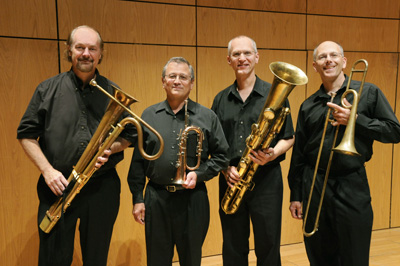 The main event of the weekend was the presentation of a concert by Berlioz Historical Brass. This concert had three parts. In Part 1, Ralph Dudgeon (keyed
bugle), Jeffrey Snedeker (natural horn), David Loucky (19th century trombone) and I (ophicleide) performed a fanfare that was written for the Historic Brass
Society by British composer Simon Proctor. It was a treat to work closely with these friends, and David Loucky and I enjoyed particular conversation about
the ophicleide. David is a fine ophicleide player; you can hear samples of his playing on
his website. The photo at left shows Craig Kridel (English bass horn),
Ralph Dudgeon (keyed bugle), myself (ophicleide) and David Loucky (19th century trombone).
The main event of the weekend was the presentation of a concert by Berlioz Historical Brass. This concert had three parts. In Part 1, Ralph Dudgeon (keyed
bugle), Jeffrey Snedeker (natural horn), David Loucky (19th century trombone) and I (ophicleide) performed a fanfare that was written for the Historic Brass
Society by British composer Simon Proctor. It was a treat to work closely with these friends, and David Loucky and I enjoyed particular conversation about
the ophicleide. David is a fine ophicleide player; you can hear samples of his playing on
his website. The photo at left shows Craig Kridel (English bass horn),
Ralph Dudgeon (keyed bugle), myself (ophicleide) and David Loucky (19th century trombone).
After the fanfare, the concert turned its attention to the premiere of a new work by the English composer, Clifford Bevan. Mendelssohn's Seasons was
commissioned by Berlioz Historical Brass and was written for natural horn, trombone, English bass horn and ophicleide with choir. Conceived as a tribute to the
great composer Felix Mendelssohn, the piece utilized four brass instruments that Mendelssohn used in his works. The conductor was Wim Becu, the noted Belgian
bass sackbut player, and the choir was the Anglican Singers of New London. The photo above, at left, shows the forces assembled before the performance.
 Performing this work was a joy. Clifford Bevan is a friend, and I have recorded two of his previous compositions, Les Mots de Berlioz and
Variations on "The Pesky Sarpent" on my compact disc of music for
serpent,
Le Monde du Serpent. A member of the
London Serpent Trio, he is also the author of the definitive book on
the history of the tuba and the bass brasses that preceeded it - including serpent and ophicleide - The Tuba Family. The choir was excellent and Wim Becu brought out the very
best in all of the participants.
Performing this work was a joy. Clifford Bevan is a friend, and I have recorded two of his previous compositions, Les Mots de Berlioz and
Variations on "The Pesky Sarpent" on my compact disc of music for
serpent,
Le Monde du Serpent. A member of the
London Serpent Trio, he is also the author of the definitive book on
the history of the tuba and the bass brasses that preceeded it - including serpent and ophicleide - The Tuba Family. The choir was excellent and Wim Becu brought out the very
best in all of the participants.
Craig Kridel played the English bass horn (pictured at left, along side me, playing ophicleide), a short-lived form of upright serpent that Mendelssohn
used in a number of his works including A Midsummer Night's Dream. This concert was a rare opportunity for people to hear the sound of the English bass horn as
it is exceedingly rare to see one in performance; in fact, Craig is the world's leading exponent of this fascinating instrument.
The final part of my involvement in the concert was giving the world premiere of Therese Brenet's De bronze et lumiere, a solo for serpent and piano. This
was a special opportunity to bring the serpent squarely into the 21st century. My accompanist, John Anthony, and I were delighted with the strong response of the
audience that enthusiastically greeted our performance. Therese Brenet is perhaps the most well known composer to write for the serpent since Hector Berlioz, and
giving the premiere of this new work was a very satisfying way to conclude my involvement at the 2009 Early Brass Festival.
July 1, 2009 - NEW
Today I officially completed a six-month sabbatical from the Boston Symphony Orchestra. This was a remarkably rich time for me, during which I logged over 40,000
air miles, travelling around the world to engage in trombone recitals and teaching, early music performances, guest conducting and much more. During this time
I kept a diary of my activities which I updated every few days; today I posted the final update. Click
HERE
to visit my
SABBATICAL DIARY.
-
May 14, 2009 - COMMENTARY
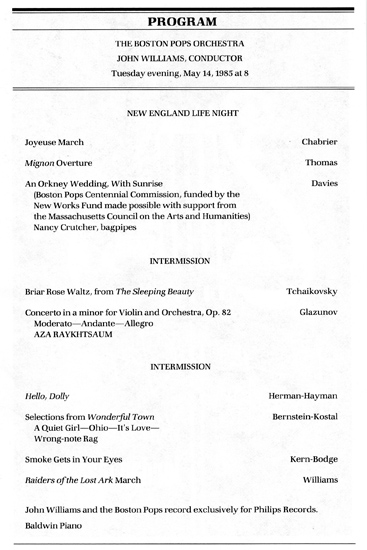 Today I celebrated another milestone of my career. 24 years ago today, I played my first concert as a member of the Boston Symphony Orchestra.
Today I celebrated another milestone of my career. 24 years ago today, I played my first concert as a member of the Boston Symphony Orchestra.
I auditioned for the Boston Symphony twice. While I was the winner of the first audition I took in 1984, then Music Director Seiji Ozawa decided not to hire anyone at that time.
Instead, I was asked to play with the BSO at its summer festival home, Tanglewood, for two weeks, travel with the orchestra on a European tour for several weeks,
and return to Boston to record Strauss' Don Quixote with Yo-Yo Ma as cello soloist. That was a great, memorable time for me, and I got a taste of what
my musical life might be like if God led my life in such a way that I might win the next BSO audition. Win it I did, in December, 1984, and on May 14, 1985, I
officially joined the Boston Symphony and played my first concert as a member.
On the night before my first BSO concert I played a concert in Carnegie Hall with the Baltimore Symphony Orchestra, my last with that fine orchestra with which
I played for four years.
The concert in Carnegie Hall had several Boston connections. The violin soloist in the Dvorak Violin Concerto was Joseph Silverstein, the Baltmore
Symphony's Principal Guest Conductor and then concertmaster of the Boston Symphony. Joe Silverstein was the person who told me that Boston would be having a
bass trombone opening and he was always very kind and encouraging to me. The final piece on the concert was Bartok's Concerto for Orchestra which received
its world premiere by the BSO in 1944. After the concert, I drove to Boston and the next day began my career with the BSO.
In May, the BSO puts on its "other hat" and turns into the Boston Pops Orchestra. My first service with the orchestra was a concert - no rehearsal - that was
televised for broadcast on "Evening at Pops," one of the longest running television series on our Public Television network. Norman Bolter was playing principal
trombone in the Boston Pops Orchestra, John Huling (who later went on to play second trombone with the National Symphony in Washington D.C.) was playing second
trombone and Chester Schmitz was the tubist. John Williams was on the podium. When I look at that first program I played (above) I smile and remember that feeling
I had when that first downbeat came. It was the begining of something very special.
There were no fireworks tonight, no big celebration to commemorate the beginning of my 25th season with the Boston Symphony. But when this day rolls around each
year, I spend some time thinking about that day many years ago when this important chapter of my life began. It has been a great ride and Lord willing
there is more yet to come.
-
May 5, 2009 - UPDATE
I have updated my
Bass Trombone Discography to add many
new recordings featuring bass trombone.
-
March 26, 2009 - NEW
I have added a new article, originally given as a chapel message at Northwestern College in Saint Paul, Minnesota.
Look For the Ancient Paths is a challenge to look at one's life and sense of calling through new eyes.
-
December 27, 2008 - NEW
 I have added a new page that talks about a DVD project I was involved in, produced by the Great Lakes Conference of the United Methodist Church. This four
part DVD,
Opening Ourselves to Grace: Basic Christian Practices
includes an interview of me, footage of my leading the New England Brass Band, and an interview with my friend, Terry Everson, professor of trumpet at Boston
University. The subject of the DVD is the spiritual disciplines of the Christian life, as seen through the lens of the Weslyan tradition. I was very pleased to
be asked to be a part of this project and highly recommend the DVD to anyone interested in the subject of the Christian faith. I have also included my interview on this page via a link to YouTube.
I have added a new page that talks about a DVD project I was involved in, produced by the Great Lakes Conference of the United Methodist Church. This four
part DVD,
Opening Ourselves to Grace: Basic Christian Practices
includes an interview of me, footage of my leading the New England Brass Band, and an interview with my friend, Terry Everson, professor of trumpet at Boston
University. The subject of the DVD is the spiritual disciplines of the Christian life, as seen through the lens of the Weslyan tradition. I was very pleased to
be asked to be a part of this project and highly recommend the DVD to anyone interested in the subject of the Christian faith. I have also included my interview on this page via a link to YouTube.
For more information about the DVD, or to view the interviews of me and
Terry Everson, visit my new
Opening Ourselves To Grace page.
-
December 24, 2008 - NEW
As of today, I have begun my six month sabbatical from the Boston Symphony Orchestra. During that time, I will keep a
sabbatical diary that will contain commentary and photos of some of my exploits and explorations. This is an
exciting time for me and I hope you enjoy sharing in the journey with me.
-
December 21, 2008 - COMMENTARY
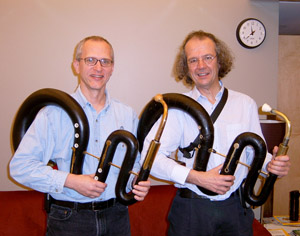 One of the great joys of my life is my exploration into the world of early music. I first began playing that most unusual of instruments, the serpent,
in 1994, for perfomances with the Boston Symphony of Hector Berlioz's Messe solennelle. Since that time, I've enjoyed a great many musical highlights
in the world of early music and the friendships I have made as a result have been very special and satisfying. Several years ago, I met Phil Humphries, an
Englishman from Dorset, who graciously came to America in 2003 to play both serpent and ophicleide on my CD,
Le Monde du Serpent. Phil is a music teacher in England and, as well,
a fine trombonist. He is also the serpent player for
The London Serpent Trio and
The Mellstock Band, a group of four musicians who work to recreate the sight and
sound of 19th century Britain through the words and music of the era of author Thomas Hardy. This month, The Mellstock Band has been in Boston to take part in the
annual
Christmas Revels that take place each year at Sanders Theater at Harvard University.
One of the great joys of my life is my exploration into the world of early music. I first began playing that most unusual of instruments, the serpent,
in 1994, for perfomances with the Boston Symphony of Hector Berlioz's Messe solennelle. Since that time, I've enjoyed a great many musical highlights
in the world of early music and the friendships I have made as a result have been very special and satisfying. Several years ago, I met Phil Humphries, an
Englishman from Dorset, who graciously came to America in 2003 to play both serpent and ophicleide on my CD,
Le Monde du Serpent. Phil is a music teacher in England and, as well,
a fine trombonist. He is also the serpent player for
The London Serpent Trio and
The Mellstock Band, a group of four musicians who work to recreate the sight and
sound of 19th century Britain through the words and music of the era of author Thomas Hardy. This month, The Mellstock Band has been in Boston to take part in the
annual
Christmas Revels that take place each year at Sanders Theater at Harvard University.
Phil and enjoyed collaborating on two pre-concert talks on December 20 and 21, introducing the serpent to audiences. Phil played his c. 1840 English military
serpent by Francis Pretty and I played my English military serpent by the late Keith Rogers, which is a copy of a Pretty serpent owned by Andrew van der Beek,
an original member of the London Serpent Trio; the photo at left was taken in my locker room at Symphony Hall in Boston as we rehearsed and planned our
talk. We had such great fun, and I recommend the Revels to anyone who wants to have a very creative, enjoyable evening
of entertainment centered around Christmas time.
I will look forward to seeing Phil again in May when I travel to England to take part in the 2009
Serpentarium. My serpentine adventures continue!
-
November 26, 2008 - COMMENTARY
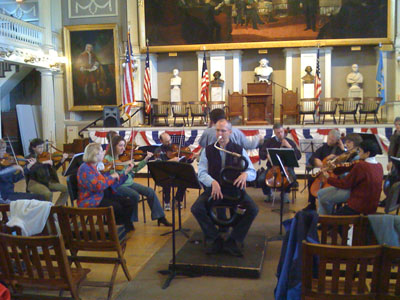 This past weekend, I had the great pleasure of helping bring a new piece of music to life - the world premiere of
Gordon Bowie's
concerto for serpent, Old Dances in New Shoes.
Gordon is a fine composer living in Washington DC. A long time resident of Maine, Gordon and I met in the mid-90s. He attended
my 1997 recital in Boston
that was notable for the fact that three feet of snow fell that evening. Gordon was stranded in Boston for a few days at which time he began working on a duet for two bass trombones,
Second Base Blues (the title was inspired by the fact that Gordon was staying at the Howard Johnson's motel at Fenway Park in Boston, home of the Boston Red Sox). On
that recital, I played Simon Proctor's Serpent Concerto, and Clifford Bevan's serpent solo, Variations on the Pesky Sarpent; this was the first time Gordon
had ever heard the serpent. In the fall of 1998, I was the guest artist (and Gordon was composer-in-residence) at a trombone workshop hosted by North Central College (Naperville, Illinois) and
Gordon gave me some sketches for a new serpent concerto. The piece was finished later that year and now - 10 years later - I was finally able to find just the right opportunity, orchestra and
audience to put on the premiere.
This past weekend, I had the great pleasure of helping bring a new piece of music to life - the world premiere of
Gordon Bowie's
concerto for serpent, Old Dances in New Shoes.
Gordon is a fine composer living in Washington DC. A long time resident of Maine, Gordon and I met in the mid-90s. He attended
my 1997 recital in Boston
that was notable for the fact that three feet of snow fell that evening. Gordon was stranded in Boston for a few days at which time he began working on a duet for two bass trombones,
Second Base Blues (the title was inspired by the fact that Gordon was staying at the Howard Johnson's motel at Fenway Park in Boston, home of the Boston Red Sox). On
that recital, I played Simon Proctor's Serpent Concerto, and Clifford Bevan's serpent solo, Variations on the Pesky Sarpent; this was the first time Gordon
had ever heard the serpent. In the fall of 1998, I was the guest artist (and Gordon was composer-in-residence) at a trombone workshop hosted by North Central College (Naperville, Illinois) and
Gordon gave me some sketches for a new serpent concerto. The piece was finished later that year and now - 10 years later - I was finally able to find just the right opportunity, orchestra and
audience to put on the premiere.
 In 1997, I had played Simon Proctor's Serpent Concerto with the
Boston Classical Orchestra,
conducted by its then music director, Harry Ellis Dickson. The BCO is a chamber orchestra, now conducted by Steven Lipsitt, that gives a series of concerts each year in Boston's historic Faneuil Hall.
The orchestra has hosted many soloists of "unusual instruments" including a tuba duet, glass harmonica, alphorn and serpent. The venue is intimate and the audience is always very engaged. I approached
Steven Lipsitt earlier this year about the possibility of my premiering a new concerto on serpent and, as well, playing a solo on ophicleide. Steven was immediately responsive to the idea and
the performances last weekend were a rousing success. Gordon's serpent concerto is the most difficult thing I have ever played on serpent, a tremendous challenge. The orchestra played beautifully
and I was especially happy that the composer could make the trip to Boston to enjoy the performances. I also played an aria by Handel, his "O Ruddier Than The Cherry" from the opera
Acis and Galatea, on ophicleide, in tribute to the great 19th century ophicleide player, Samuel Hughes, who had popularized the piece in performances with the celebrated Cyfartha
Band (Wales) and Jullien's orchestra in the mid 19th century.
In 1997, I had played Simon Proctor's Serpent Concerto with the
Boston Classical Orchestra,
conducted by its then music director, Harry Ellis Dickson. The BCO is a chamber orchestra, now conducted by Steven Lipsitt, that gives a series of concerts each year in Boston's historic Faneuil Hall.
The orchestra has hosted many soloists of "unusual instruments" including a tuba duet, glass harmonica, alphorn and serpent. The venue is intimate and the audience is always very engaged. I approached
Steven Lipsitt earlier this year about the possibility of my premiering a new concerto on serpent and, as well, playing a solo on ophicleide. Steven was immediately responsive to the idea and
the performances last weekend were a rousing success. Gordon's serpent concerto is the most difficult thing I have ever played on serpent, a tremendous challenge. The orchestra played beautifully
and I was especially happy that the composer could make the trip to Boston to enjoy the performances. I also played an aria by Handel, his "O Ruddier Than The Cherry" from the opera
Acis and Galatea, on ophicleide, in tribute to the great 19th century ophicleide player, Samuel Hughes, who had popularized the piece in performances with the celebrated Cyfartha
Band (Wales) and Jullien's orchestra in the mid 19th century.
The photos on left and right show me in rehearsal with the Boston Classical Orchestra in Faneuil Hall. A special part of the week of rehearsals and concerts was a radio interview I gave in the
studios of WBUR, Boston's National Public Radio station, on the nationally syndicated program "Here and Now" with Robin Young. The interview afforded me an opportunity to talk in some depth about the serpent and
ophicleide and demonstrate both instruments.
The interview is archived on the "Here and Now" website along with photos and a video from the interview.
I was also pleased that the Boston Globe's music critic, Jeremy Eichler, gave the concert
a positive review
titled, "A serpentine member of orchestras past." Complimentary of not only my own
playing but of the orchestra and Gordon Bowie's compositional gift, the review was a generous and satsifying conclusion to a very special week of music making in my home town.
-
November 15, 2008 - COMMENTARY
 Life is too short not to have moments of hilarious fun, and one of
my ridiculous hobbies is collecting that ubiquitous tacky souvenir, the floaty pen. My collecting of these little items - that can often be found at airports or gift shops at tourist destinations -
began in 1984 when I was on a Boston Symphony tour of Europe. Since that time, I have collected over 900 pens from around the world. Several years ago, I decided that I'd like to have my own
floaty pen, a kind of kitchy business card. With the advice of the floaty pen "queen," Diana Andra, and the assistance of floaty
pen designer Nancy Nerenberg,
I produced two different versions of what
I called the Douglas Yeo Floaty Pen. Today I sold the last of those designs. Perhaps it is appropriate that the last
of my pens have been purchased by the Boston Symphony Shop at Symphony Hall; my pen features an image of Symphony Hall into which I "float" and the pen has been a good seller for
the Shop over the years. It was fun to have these pens available but with 1500 of them now in circulation, I guess - for those who collect
these things - they are officially "collector's items" since I will not be making any more. For those interested, my third pen design, one made in conjunction with my CD Le Monde du
Serpent, is still available. To all of you who particpated in the fun over the years by buying one of my pens, you have my thanks.
The end of an era, with a smile.
Life is too short not to have moments of hilarious fun, and one of
my ridiculous hobbies is collecting that ubiquitous tacky souvenir, the floaty pen. My collecting of these little items - that can often be found at airports or gift shops at tourist destinations -
began in 1984 when I was on a Boston Symphony tour of Europe. Since that time, I have collected over 900 pens from around the world. Several years ago, I decided that I'd like to have my own
floaty pen, a kind of kitchy business card. With the advice of the floaty pen "queen," Diana Andra, and the assistance of floaty
pen designer Nancy Nerenberg,
I produced two different versions of what
I called the Douglas Yeo Floaty Pen. Today I sold the last of those designs. Perhaps it is appropriate that the last
of my pens have been purchased by the Boston Symphony Shop at Symphony Hall; my pen features an image of Symphony Hall into which I "float" and the pen has been a good seller for
the Shop over the years. It was fun to have these pens available but with 1500 of them now in circulation, I guess - for those who collect
these things - they are officially "collector's items" since I will not be making any more. For those interested, my third pen design, one made in conjunction with my CD Le Monde du
Serpent, is still available. To all of you who particpated in the fun over the years by buying one of my pens, you have my thanks.
The end of an era, with a smile.
-
September 27, 2008 - COMMENTARY
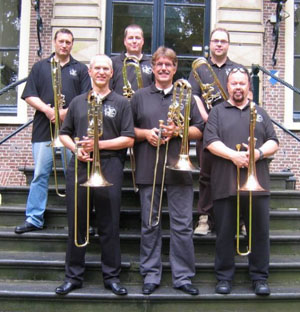 As I mentioned in my commentary below (September 19), this has been a very busy fall for me and I am just able to catch up on some more website updates. More are to come; thanks for your
patience!
As I mentioned in my commentary below (September 19), this has been a very busy fall for me and I am just able to catch up on some more website updates. More are to come; thanks for your
patience!
Earlier this month I made a trip to The Netherlands to take part in one of the most memorable trombone events of my career, the
Dutch Bass Trombone Open.
This event, held near Amsterdam,
was the brain-child of three Dutch bass trombonists: Marcel Schott, Erwin Dijkstra and Bert Damsma. I had heard about the first DBTO, held in 2006, where Bill Reichenbach, Ben van Dijk
and Csaba Wagner were the artist/teachers. When I was invited to come to the 2008 edition of the DBTO, I was thrilled to hear that my friend Ben van Dijk would be there as well as Phil Teele,
one of the great bass trombone players in the west coast studio tradition. The photo at left shows the team, with Bert, Erwin and Marcel (top) with me, Ben and Phil (bottom)
Held in the castle (now converted to a hotel and conference center) Oud Poelgeest, this was one of the best organized and most enjoyable events I have ever been a part of. This is due
to the fact that the DBTO team - Marcel, Erwin and Bert - did a fantastic job of organizing the event and providing both faculty and participants with every possible convenience. It was a
fast paced but also very relaxed event. In total there were 42 bass trombone players in attendance from 13 countries (the DBTO is very proud to say that, "No tenor trombones were harmed in this event."), and they
were divided into two groups. Each group met concurrently with either Phil Teele or with me, and we gave the same sessions to each group. My topics were, "Legato: Unlocking the Mystery" and
"One Size Does NOT Fit All." I also gave a session for the whole group on the important subject of ergonomics. I found the participants to be very responsive to all of the comments of the teachers throughout the weekend, and we all interacted very well and collegially. To
see a group of players of various playing levels and ages - from students to retired players, from fine players to those who were less accomplished - work together so nicely was a real pleasure.
There was no sense of competetiveness between all of us - we were all there to learn, interact and have a good time.
 I couldn't possibly mention all of the highlights of the weekend - which went by much too quickly - but here are a few. The food was absolutely fantastic. Oud Poelgeest is a really interesting
place to have the event and I enjoyed the architecture of the various buildings and the setting was truly beautiful and inspiring. Seeing Phil Teele in action - his book of pedal tone warm-up
exercises is nearly legandary - was a special treat; we became good friends through the weekend. Phil has played on over 1000 movie scores and we enjoyed sharing stories about John Williams and
other conductors and composers for whom we have each worked. Being with Ben van Dijk again was wonderful; Ben is one of the most positive people I have ever met and he demonstrated his
fine playing at the faculty recital on the first evening. The trombone ensembles were great fun to work with - whether I was conducting (20 bass trombone players in Ben's arrangement of
excerpts from Wagner's "Ring Cycle" for bass trombone ensemble - see the photo, right), listening (to Phil conduct an arrangement of music from "The Pirates of Penzance" for 20 bass trombones) or playing (in Bill Reichenbach's
"Getting Medieval" played by 41 bass trombonists).
I couldn't possibly mention all of the highlights of the weekend - which went by much too quickly - but here are a few. The food was absolutely fantastic. Oud Poelgeest is a really interesting
place to have the event and I enjoyed the architecture of the various buildings and the setting was truly beautiful and inspiring. Seeing Phil Teele in action - his book of pedal tone warm-up
exercises is nearly legandary - was a special treat; we became good friends through the weekend. Phil has played on over 1000 movie scores and we enjoyed sharing stories about John Williams and
other conductors and composers for whom we have each worked. Being with Ben van Dijk again was wonderful; Ben is one of the most positive people I have ever met and he demonstrated his
fine playing at the faculty recital on the first evening. The trombone ensembles were great fun to work with - whether I was conducting (20 bass trombone players in Ben's arrangement of
excerpts from Wagner's "Ring Cycle" for bass trombone ensemble - see the photo, right), listening (to Phil conduct an arrangement of music from "The Pirates of Penzance" for 20 bass trombones) or playing (in Bill Reichenbach's
"Getting Medieval" played by 41 bass trombonists).
It was also great to see Yamaha (which was a major sponsor of the event), Thein and Atelier Pfeiffer (a leading music shop in The Netherlands) all display instruments and accessories for
everyone to try and buy. A special highlight for me was performing as soloist with Brassband Schoonhoven conducted by Erik Jansen. I chose to play several pieces that I recorded on my
CD, "Proclamation" including the title track by Gordon Langford and Bill Geldard's "Stella By Starlight" in tribute to George Roberts. A special treat was being asked - at the last minute - to
play Joy Webb's "Share My Yoke." The timing of that request was nearly perfect as I had been rehearsing that piece to play at my youngest daughter's wedding a few days after the DBTO. It was
very rewarding to hear several participants tell me that my performance of "Share My Yoke" was a highlight of the weekend for them.
In all, the DBTO 2008 was a very satisfying experience in every way. I could not have asked for better hosts, better organization, more responsive participants and a more ideal location for
such an event. Happily, there are many ways people can learn about the DBTO - through the
Dutch Bass Trombone Open Website (once in the site, click on Fotos and you can see many photos of both the 2006 and 2008 event), on YouTube -
search for both Dutch Bass Trombone Open and
DBTO, and on the
Dutch Bass Trombone Open Facebook site. Thanks again to Marcel, Erwin and Bert for organizing a great event.
The next DBTO will be in 2010 and I highly recommend it to all bass trombonists who want to enjoy a weekend of good teaching, playing and collegial interaction with bass trombone
players from around the world. Bravo to the DBTO team!
-
September 19, 2008 - COMMENTARY
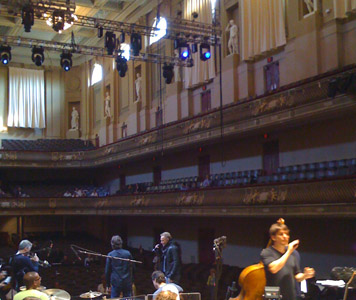 It's been a busy fall since the end of the Boston Symphony's summer season at Tanglewood, and that will be reflected in several new entries on this page over the coming days.
It's been a busy fall since the end of the Boston Symphony's summer season at Tanglewood, and that will be reflected in several new entries on this page over the coming days.
This week, I've been taking part in one of the most interesting and unusual musical performances of my career. Over the summer, we in the Boston Symphony got word of two possible Boston
Pops concerts/media projects. They were tentative at first but firmed up just as we were leaving for vacation at the end of August. Both are occurring this week and the first is already under
way. Sony is producing a new event with jazz trumpeter Chris Botti and the Boston Pops Orchestra is backing up the concert in Boston's Symphony Hall. Botti is a fine trumpet player - the real deal -
and this concert (actually two concerts - one was last night and the other is tonight) is more than just a concert with Botti and his combo. Rather, it is an event full of pop and classical music
superstars including Sting, Steven Tyler, Katharine McPhee (of American Idol), John Mayer, Josh Groban and Yo-Yo Ma. It's a "who's who" of American popular culture. Ordinarily these kinds
of things don't even appear on my radar screen - I don't have any interest in the "cult of the personality" and most rock and pop music leaves me looking for musical substance elsewhere, but I have
to say that this event has been very satisfying in many ways. While the orchestra has its role to play, it's been interesting to be on stage and watch the whole thing unfold - the collaboration
between the artists, the way these kinds of pop/rock concerts are produced, and all the rest. The photo to the left was taken from my seat on stage at yesterday's rehearsal
and shows Chris Botti (with trumpet, left)
with Josh Groban and Sting (Boston Pops conductor Keith Lockhart is also seen, on the right), rehearsing Sting's "The Shape of My Heart." It is a haunting song and easily the highlight of the evening for me.
Look for a CD release of the concert in December, "Chris Botti Live in Boston". A TV show will be on the Public Broadcasting System (PBS) in the USA in March and a concert DVD will also be
released at that time. For a slice of American pop culture, this has been a surprisingly enjoyable experience. I'm heading over to iTunes to download some more songs by Sting.
As to the other Pops project this week, it occurs over the weekend and is a "heavy metal" version of Handel's "Messiah." Wow...
-
June 23, 2008 - COMMENTARY
 As mentioned in my entry for June 9, 2008 (below), it has been an exciting time in Boston, watching the Boston Celtics play in the National Basketball Association Finals against the
Los Angeles Lakers. The thrill of having played the National Anthem with members of the Boston Pops brass section at Game 2 of the Finals is still hard to express. It carried with it so
many emotions and experiences, not the least of which was the fevered pitch that accompanied watching the remaining games in the series. The Los Angeles Lakers forced a game six in the series
and my wife and I were on vacation during the last two games. We enjoyed a week in Bermuda, at one of our favorite vacation spots,
Willowbank, a small hotel in Sandys Parish that is one of the most beautiful and restful places we have visited. This was our 10th time
at Willowbank but there was one small problem with our visit this time: Willowbank fights against the tide of typical hotels by not having televisions in guest rooms. This is a master stroke - it
removes the "eye" that is the television from a vacation, allowing one to simply enjoy God's great beauty of the island without the intruding distraction of television. Ordinarily this is one of
the great "plusses" of Willowbank, but when we arrived, we knew that we would want to find a way to watch at least one more game, with the Celtics ahead, three games to one and needing to win a
all important fourth game. Fortunately, Willowbank Manager Terri Allison graciously arranged for us - along with a small cadre of enthusiastic Celtics fan guests - to watch the games
on a wide screen television - a special dispensation that was happily cheered. With a one hour time change in Bermuda, games began at 10:00 pm and didn't end until after 1:30 am. When the Celtics
narrowly lost Game 5 on Sunday, June 15, we knew there would be at least one more late night. Happily, that occurred on June 17, with the Celtics decisively defeating the Lakers, 131-92.
To be in Bermuda cheering the Celtics with new friends at Willowbank was a treat, and celebrating Boston's sixth professional sport championship (New England Patriots football Super
Bowl championships in 2002, 2004 and 2005, Boston Red Sox baseball World Series Championships in 2004 and 2007 and now the Celtics championship in 2008) in six years, is part of this
rare time in our home town. It has not always been like this with Boston sports and it cannot go on forever. But for now, it is exciting to be living in what we will surely look back on as
"the good old days" and enjoy the success of Boston sports teams.
As mentioned in my entry for June 9, 2008 (below), it has been an exciting time in Boston, watching the Boston Celtics play in the National Basketball Association Finals against the
Los Angeles Lakers. The thrill of having played the National Anthem with members of the Boston Pops brass section at Game 2 of the Finals is still hard to express. It carried with it so
many emotions and experiences, not the least of which was the fevered pitch that accompanied watching the remaining games in the series. The Los Angeles Lakers forced a game six in the series
and my wife and I were on vacation during the last two games. We enjoyed a week in Bermuda, at one of our favorite vacation spots,
Willowbank, a small hotel in Sandys Parish that is one of the most beautiful and restful places we have visited. This was our 10th time
at Willowbank but there was one small problem with our visit this time: Willowbank fights against the tide of typical hotels by not having televisions in guest rooms. This is a master stroke - it
removes the "eye" that is the television from a vacation, allowing one to simply enjoy God's great beauty of the island without the intruding distraction of television. Ordinarily this is one of
the great "plusses" of Willowbank, but when we arrived, we knew that we would want to find a way to watch at least one more game, with the Celtics ahead, three games to one and needing to win a
all important fourth game. Fortunately, Willowbank Manager Terri Allison graciously arranged for us - along with a small cadre of enthusiastic Celtics fan guests - to watch the games
on a wide screen television - a special dispensation that was happily cheered. With a one hour time change in Bermuda, games began at 10:00 pm and didn't end until after 1:30 am. When the Celtics
narrowly lost Game 5 on Sunday, June 15, we knew there would be at least one more late night. Happily, that occurred on June 17, with the Celtics decisively defeating the Lakers, 131-92.
To be in Bermuda cheering the Celtics with new friends at Willowbank was a treat, and celebrating Boston's sixth professional sport championship (New England Patriots football Super
Bowl championships in 2002, 2004 and 2005, Boston Red Sox baseball World Series Championships in 2004 and 2007 and now the Celtics championship in 2008) in six years, is part of this
rare time in our home town. It has not always been like this with Boston sports and it cannot go on forever. But for now, it is exciting to be living in what we will surely look back on as
"the good old days" and enjoy the success of Boston sports teams.
-
June 9, 2008 - COMMENTARY
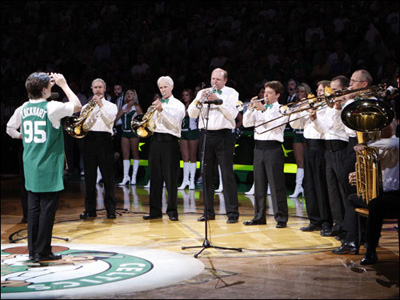
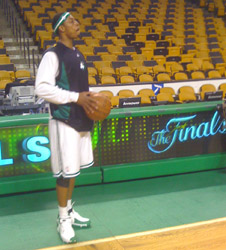 Over the years, I've been fortunate to attend a number of special events with my bass trombone in my hand. Yesterday was one of those days. Early last week, members of the Boston Pops
brass section were informed that we had been invited to play the National Anthem at Game 2 of the National Basketball Association finals; a game between the Boston Celtics and the
Los Angeles Lakers. What a thrill this was! Conductor Keith Lockhart led a group of 10 brass and percussion players at center court (in the photo at left, shown from left to right, are
Jonathan Menkis and Richard Sebring, horns; Thomas Rolfs, Banjamin Wright and Bruce Hall, trumpets; James Nova and myself, trombones, and Gary Ofenloch, tuba; not visible on the left
are percussion players Lee Vinson and Richard Flanagan). During our sound check on the
court earlier in the evening, I got
to stand just a few feet away from Celtics players including Paul Pierce (photo at right). To watch these men ply their craft - really, it is an art - is a thing of beauty. The TD Bank North Garden is
a new replacement for the old Boston Garden and is a great venue for basketball. I had previously attended several other games at the Garden, always with Boston Pops brass players, but there is
nothing like watching the finals of a sporting event. The electricity in the air was palpable. Later, backstage, basketball great Kareem Abdul-Jabbar (7 feet, 2 inches tall) walked by - his head at the top of Mount Everest while I (a mere 6 feet tall) looked up
at him in amazement. The NBA gave all of the Pops players tickets to the game and we had terrific seats to watch this exciting game unfold. While the Celtics were up by 24 points at one point,
the Lakers stormed back to within two points in the fourth quarter before the Celtics finished with a 108-102 win. With the Celtics ahead of the Lakers two games to none, it is on to Los Angeles
where the Celtics hope to upset the heavily favored west coast team.
Over the years, I've been fortunate to attend a number of special events with my bass trombone in my hand. Yesterday was one of those days. Early last week, members of the Boston Pops
brass section were informed that we had been invited to play the National Anthem at Game 2 of the National Basketball Association finals; a game between the Boston Celtics and the
Los Angeles Lakers. What a thrill this was! Conductor Keith Lockhart led a group of 10 brass and percussion players at center court (in the photo at left, shown from left to right, are
Jonathan Menkis and Richard Sebring, horns; Thomas Rolfs, Banjamin Wright and Bruce Hall, trumpets; James Nova and myself, trombones, and Gary Ofenloch, tuba; not visible on the left
are percussion players Lee Vinson and Richard Flanagan). During our sound check on the
court earlier in the evening, I got
to stand just a few feet away from Celtics players including Paul Pierce (photo at right). To watch these men ply their craft - really, it is an art - is a thing of beauty. The TD Bank North Garden is
a new replacement for the old Boston Garden and is a great venue for basketball. I had previously attended several other games at the Garden, always with Boston Pops brass players, but there is
nothing like watching the finals of a sporting event. The electricity in the air was palpable. Later, backstage, basketball great Kareem Abdul-Jabbar (7 feet, 2 inches tall) walked by - his head at the top of Mount Everest while I (a mere 6 feet tall) looked up
at him in amazement. The NBA gave all of the Pops players tickets to the game and we had terrific seats to watch this exciting game unfold. While the Celtics were up by 24 points at one point,
the Lakers stormed back to within two points in the fourth quarter before the Celtics finished with a 108-102 win. With the Celtics ahead of the Lakers two games to none, it is on to Los Angeles
where the Celtics hope to upset the heavily favored west coast team.
When I was nine years old and started playing the trombone, if someone had told me that as a result of playing the trombone, I would have played at a
National Football League Superbowl (Superbowl XXXVI),
an NBA Finals game, and a Major League Baseball American League Champoinship Series game (Boston Red Sox vs. New York Yankees - the Red Sox won), as well as innumerable
other sporting events, I would have told you that you were crazy. But such is my life, full of unexpected blessings and pleasures. Go Celtics! Beat LA!
-
June 2, 2008 - NEW
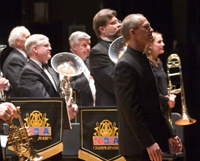 Since 1998, I have been privileged to serve as music director of the New England Brass Band.
These 10 years have been very rich ones for me, as I have thoroughly enjoyed
working with this fine group of volunteers who work tirelessly to bring high-level music making to audiences around the world. In my entry for January 12, 2008 (see below) I
wrote about how this season would be my last as leader of the NEBB. Yesterday I conducted my final concert with the band. This concert, held at Hope Church in Lenox, Massachusetts,
was a program of sacred music that is very special to me. Before the concert, I addressed the members of the band, to thank them for all they had done over the last 10 years and to give
them some thoughts as they move forward under the leadership of their new music director, Stephen Bulla. I have decided to post my address to the band here on my website along with some
photos taken over the last few years that will give readers a sense of what a tremendous time we have had together.
Titled, New England Brass Band: Gratitude 2008, I hope this article is a lasting reminder to all
members of the New England Brass Band - both past and present - of their deep impact upon my life. This photo (left) is symbolic of today's milestone: it shows me with the New England Brass
Band taking our final bow at the 2008 North American Brass Band Association XXVI Championships. This was the last time I conducted the NEBB at the NABBA Championships and this photo of our
final bow can only begin to communicate the strong emotions I was feeling as I stood in front of this band of fine men and women who have given so much to bring pleasure to audiences around
the world through their music making.
Since 1998, I have been privileged to serve as music director of the New England Brass Band.
These 10 years have been very rich ones for me, as I have thoroughly enjoyed
working with this fine group of volunteers who work tirelessly to bring high-level music making to audiences around the world. In my entry for January 12, 2008 (see below) I
wrote about how this season would be my last as leader of the NEBB. Yesterday I conducted my final concert with the band. This concert, held at Hope Church in Lenox, Massachusetts,
was a program of sacred music that is very special to me. Before the concert, I addressed the members of the band, to thank them for all they had done over the last 10 years and to give
them some thoughts as they move forward under the leadership of their new music director, Stephen Bulla. I have decided to post my address to the band here on my website along with some
photos taken over the last few years that will give readers a sense of what a tremendous time we have had together.
Titled, New England Brass Band: Gratitude 2008, I hope this article is a lasting reminder to all
members of the New England Brass Band - both past and present - of their deep impact upon my life. This photo (left) is symbolic of today's milestone: it shows me with the New England Brass
Band taking our final bow at the 2008 North American Brass Band Association XXVI Championships. This was the last time I conducted the NEBB at the NABBA Championships and this photo of our
final bow can only begin to communicate the strong emotions I was feeling as I stood in front of this band of fine men and women who have given so much to bring pleasure to audiences around
the world through their music making.
-
May 1, 2008 - COMMENTARY
Today marked an important milestone in the history of the Boston Symphony. After a long and demanding audition process, Toby Oft won the audition for the position of
Principal Trombonist of the Boston Symphony Orchestra. He becomes the orchestra's 12th Principal Trombone player. Toby is currently principal trombonist of the San Diego
Symphony and we look forward to his joining the BSO in the fall of 2008. I congratulate Toby (BRAVO!) and am looking forward to his coming to Boston as we will work together to build the
Boston Symphony trombone section of the future. For more about Toby, visit
tobyoft.com.
-
March 20, 2008 - UPDATE
Updated schedule page with many concerts and activities for 2008-2009 including some events that will take place during
my sabbatical from the Boston Symphony Orchestra.
-
March 8, 2008 - NEW
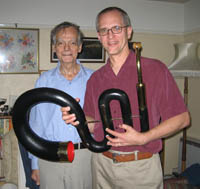 On January 21, 2008, my friend, Keith Rogers, serpent maker for Christopher Monk Instruments in England, passed from this world to the next after a battle
with cancer. Keith was my friend, a rare person who was not only a fine craftsman and loving husband and father, but a devoted servant of his God, and one with
whom I had a deep and abiding friendship. Keith made two serpents for me, among the nearly 100 he made in his lifetime: in 1996 he made a French church serpent and in 2007, he made an English military serpent. He
also made several mouthpieces for those instruments and for the remarkable contrabass serpent, "George" that I now own, that was one of the last instruments Christopher Monk
made (1990) before he died in 1991. These instruments and mouthpieces were beautifully and lovingly made and they carry the imprint of a master craftsman.
I enjoyed a very special visit with Keith just a few months before he died, at his home in England in September 2008; it was a time where God gave Keith remarkable strength
so we could enjoy vibrant conversation about many things, and he was able to work in his workshop for what would be the last time. This tribute to
Keith contains several photos of my visit with him and offers a look at this man that is personal and heartfelt. This tribute will appear in the April 2008 issue of
The Serpent Newsletter.
I hope you will click on this link and share my tribute to my friend,
Remembering Keith Rogers.
On January 21, 2008, my friend, Keith Rogers, serpent maker for Christopher Monk Instruments in England, passed from this world to the next after a battle
with cancer. Keith was my friend, a rare person who was not only a fine craftsman and loving husband and father, but a devoted servant of his God, and one with
whom I had a deep and abiding friendship. Keith made two serpents for me, among the nearly 100 he made in his lifetime: in 1996 he made a French church serpent and in 2007, he made an English military serpent. He
also made several mouthpieces for those instruments and for the remarkable contrabass serpent, "George" that I now own, that was one of the last instruments Christopher Monk
made (1990) before he died in 1991. These instruments and mouthpieces were beautifully and lovingly made and they carry the imprint of a master craftsman.
I enjoyed a very special visit with Keith just a few months before he died, at his home in England in September 2008; it was a time where God gave Keith remarkable strength
so we could enjoy vibrant conversation about many things, and he was able to work in his workshop for what would be the last time. This tribute to
Keith contains several photos of my visit with him and offers a look at this man that is personal and heartfelt. This tribute will appear in the April 2008 issue of
The Serpent Newsletter.
I hope you will click on this link and share my tribute to my friend,
Remembering Keith Rogers.
-
February 8, 2008 - NEW
Composer David Brubeck has composed a series of pieces for unaccomapnied bass trombone called, Stereograms. One of
these pieces, Stereogram 31 is based on the great hymn tune, How Great Thou Art and has been dedicated to me;
David has generously offered the piece as a free download
for visitors to my website. Go to this new
STEROGRAM page on my website to read more about David Brubeck's Stereogram 31
and download the music. Enjoy!
-
January 12, 2008 - COMMENTARY
 Since September 1998, I have been Music Director of the New England Brass Band. My 10 year involvement with the NEBB has been been one of great personal
satisfaction. But nothing can last forever and I have announced to the band that this season will be my last as its conductor.
Since September 1998, I have been Music Director of the New England Brass Band. My 10 year involvement with the NEBB has been been one of great personal
satisfaction. But nothing can last forever and I have announced to the band that this season will be my last as its conductor.
I can thank my friend, Roger Green, of County Wiltshire, England, for introducing me to the sound of the British Brass Band in the mid 1980s. My interest in
this kind of ensemble - which I had never heard or even heard of before Roger introduced me to it - grew over the years and reached a climax when I travelled to
England to record my first solo CD, Proclamation with the Black Dyke Mills Band. Several pieces
were commissioned for inclusion on that recording and when I asked around the Boston area if there was a brass band with which I might be able to read through
the new music, I was introduced to the New England Brass Band. Several years later, when then Music Director William Rollins stepped down from leading the band through
its first nine years, I was asked to take over the podium. Initially a bit reluctant due to my already busy schedule, I was persuaded to accept the band's
invitation - by my wife, who had for some time wanted a group in which she could play baritone horn. And so began a 10 year collaboration that has far
exceeded my wildest thoughts when I first began.
The activities of the band are detailed on the New England Brass Band's website. But a few
highlights are worth remembering here. The NEBB has attended the
North American Brass Band Association
Championships five times (and will return a sixth
time in March 2008). In 2004 the band won first place in the "Challenge" section and in 2006 it took first place in the "Honors" section (scroll down on this
page to the entries for April 2, 2006 and April 17, 2004, for some commentary on those events). These trips to the NABBA Championships have been rich times for
the band as we have prepared to give very special performances. We have also recorded five best selling CDs, the most recent of which,
Be Glad Then America, was released in November of this year (see the entry
for November 17 on this page); it has subsequently been awarded first place in the 2007 North American Brass Band Association "Recording of the Year" contest.
Recorded in Boston's Symphony Hall, these recordings have been one of the great joys of my 10 year collaboration with the
NEBB. We have played concerts throughout New England, from the Berkshire Hills of Massachusetts to Gorham, Maine, and dozens of venues in between. A concert
at the 2007 International Trumpet Guild Conference, a program in Symphony Hall celebrating the 125th anniversary of the Boston Symphony (where the band
was guest conducted by Boston Pops conductor, Keith Lockhart) and a concert celebrating the Golden Jubilee of Queen Elizabeth II (sponsored by the British
community in Boston) are among other highlights.
Yet the greatest highlights have been our weekly Monday night band rehearsals. These have been memorable times, both musically and socially, when the band
gathers to prepare our concert programs. I am so pleased to have been a part of this hard working, talented group of musicians who, without receiving any
salary or payment of any kind (I accept no salary, either), bring their best to the band's rehearsals each week. I will miss them. But nothing can go on forever
and I feel I am being called to some other activities that simply cannot be squeezed into my schedule as it is currently structured. This is the right
decision for the right reasons at the right time, but it is still a bit bittersweet as my wife and I will leave a group that has become such a big part of our
lives.
My last concert as Music Director of the New England Brass Band will be on June 1, 2008, at Hope Church in Lenox, Massachusetts (see the band's website for
its full concert calendar). As I cut off the last chord of the concert, a flood of memories will come over me as I move to the next stage of my relationship
with the NEBB - that of enthusiastic audience member. Until then, we will enjoy our remaining concerts and rehearsals together as we enjoy the conclusion of
this 10 year collaboration. Sempre avanti!
-
December 17, 2007 - COMMENTARY
 Today brings the end of a significant period of my life. This evening, at 10:00 PM, my trombone section colleague in the Boston Symphony and Boston Pops
Orchestras for over 22 years, Norman Bolter, will transition to a new phase in life, that of "Boston Symphony Orchestra Retiree." And with the final D major chord
of "White Christmas," Norman and I will end our long time collaboration as section mates in the BSO. One does not get many 22 year long periods in a lifetime.
I have told many people that I have spent more time with Norman than any person on earth apart from my wife and two daughters. A rough calculation tells me that
Norman and I have spent over 20,000 hours together on the job. Add to this the countless hours of being together in other contexts - recitals, recording sessions,
meals together, conversations, emails, and telephone calls - it all adds up to a lot of time spent together. And with Norman's retirement today, I will also
transition into a new phase of my life, as one who is "left behind" to carry on the legacy of the Boston Symphony trombone section, especially after the upcoming
retirement of my other BSO trombone section colleague, Ronald Barron, in the summer of 2008.
Today brings the end of a significant period of my life. This evening, at 10:00 PM, my trombone section colleague in the Boston Symphony and Boston Pops
Orchestras for over 22 years, Norman Bolter, will transition to a new phase in life, that of "Boston Symphony Orchestra Retiree." And with the final D major chord
of "White Christmas," Norman and I will end our long time collaboration as section mates in the BSO. One does not get many 22 year long periods in a lifetime.
I have told many people that I have spent more time with Norman than any person on earth apart from my wife and two daughters. A rough calculation tells me that
Norman and I have spent over 20,000 hours together on the job. Add to this the countless hours of being together in other contexts - recitals, recording sessions,
meals together, conversations, emails, and telephone calls - it all adds up to a lot of time spent together. And with Norman's retirement today, I will also
transition into a new phase of my life, as one who is "left behind" to carry on the legacy of the Boston Symphony trombone section, especially after the upcoming
retirement of my other BSO trombone section colleague, Ronald Barron, in the summer of 2008.
Together Norman and I have shared countless musical moments. They have not all been transcendent - no honest musician will tell you that every moment in performance
is all he would hope it would be. But there have been many, many special moments that we have shared, moments that have forever shaped me. Mahler 7 with
Bernard Haitink, Bruckner 3 with Kurt Sanderling, recording sessions with John Williams, premieres of Norman's compositions, "Le Grotte Cosquer" (duet for
tenor and bass trombone) and "Passions of Survival" (for trombone and orchestra - I conducted the premiere with Norman as soloist). I could not name them all
if I tried. But they are all out there, moments in time that inform other moments. And after today, they take on a new kind of meaning because I know that Norman
and I will not create any more of those moments together as members of the Boston Symphony.
While this transition is difficult and very emotional for me - after all, Norman and I are good friends who have shared music over the last two + decades of
working together - I am very happy for him. Norman and I are nearly the same age - he is five months older than me - but his life path brought him to the Boston
Symphony 10 years before I came in 1985; I held many other jobs before I came to Boston (playing for four years in the Baltimore Symphony, working as a high
school band director for two years and free lancing in New York City for three years). As a result, Norman has an opportunity to take advantage of retirement from the
Boston Symphony at a relatively young age. He has many plans for whatever days he is given in his future. You can read about Norman and his activities on his
blog, frequencybone.blogspot.com and on the website for the company he and his wife manage
that is the umbrella for the publication of Norman's compositions and his and Carol's shared musical endeavor, the "Frequency Band," which is
Air-ev Productions.
There is much, much more I could write about such a friend as Norman, and the meaning of this transition. But for now, it is best for me to use the words that
cannot be spoken. I wish my friend well in his new journey and look forward to the continued development of our friendship in the days ahead. This photo, taken
by BSO principal oboist John Ferrillo just a few days ago, shows Ron, Norman and me at Symphony Hall. I like this photo. I like it a lot. There are many stories
behind our eyes. And many more yet to be told.
-
November 24, 2007 - UPDATE
Updated schedule page with many concerts and activities for 2007-2008.
-
November 16, 2007 - NEW
 I have added a new page with information about the New England Brass Band's new CD release,
Be Glad Then America. I have been Music Director of the New
England Brass Band since 1998 and working with this group of talented, dedicated musicians has been a great pleasure. Among the many
things we have done together is release a series of compact disc recordings, the newest of which is Be Glad Then America. This new
album consists of American music on American themes composed by American compossers. With it, we have tried to give a dramatic cross section of music
that informs what is known as "The American Experiment." There are many highlights on this new CD including solos by our principal cornet player, Terry
Everson, who is also professor of trumpet at Boston University ("Bess, You Is My Woman Now"), principal euphonium Leif Reslow ("Jeanie With the Light Brown Hair"),
the band's trombone section of Don Lucas, Al Stickland, Kenneth Griffin and Don Kittle ("My Shepherd") and myself on bass trombone ("My Lord, What a Morning").
The album also has something rather unique among brass band CDs, a narration of Abraham Lincoln's "Gettysburg Address" by Charles Osgood, well known as the radio
voice of "The Osgood File." This track (of Randy Edelman's "The Gettysburg Address" from the movie, "Gettysburg") is also unusual for the fact that it includes
a part for harp, played beautifully by Judy Saiki Couture. The CD also includes the premiere recording of a new arrangement of William Schuman's "New England Triptych"
by Drew Fennell. Another special piece is "Unity Fanfare" composed by my BSO trombone section colleague, Norman Bolter. All of the New England Brass Band's recordings are very special to me as they represent particular moments in time that bring back strong
memories. But this new disc is unique in many ways and I hope you will get a copy so you can hear why.
I have added a new page with information about the New England Brass Band's new CD release,
Be Glad Then America. I have been Music Director of the New
England Brass Band since 1998 and working with this group of talented, dedicated musicians has been a great pleasure. Among the many
things we have done together is release a series of compact disc recordings, the newest of which is Be Glad Then America. This new
album consists of American music on American themes composed by American compossers. With it, we have tried to give a dramatic cross section of music
that informs what is known as "The American Experiment." There are many highlights on this new CD including solos by our principal cornet player, Terry
Everson, who is also professor of trumpet at Boston University ("Bess, You Is My Woman Now"), principal euphonium Leif Reslow ("Jeanie With the Light Brown Hair"),
the band's trombone section of Don Lucas, Al Stickland, Kenneth Griffin and Don Kittle ("My Shepherd") and myself on bass trombone ("My Lord, What a Morning").
The album also has something rather unique among brass band CDs, a narration of Abraham Lincoln's "Gettysburg Address" by Charles Osgood, well known as the radio
voice of "The Osgood File." This track (of Randy Edelman's "The Gettysburg Address" from the movie, "Gettysburg") is also unusual for the fact that it includes
a part for harp, played beautifully by Judy Saiki Couture. The CD also includes the premiere recording of a new arrangement of William Schuman's "New England Triptych"
by Drew Fennell. Another special piece is "Unity Fanfare" composed by my BSO trombone section colleague, Norman Bolter. All of the New England Brass Band's recordings are very special to me as they represent particular moments in time that bring back strong
memories. But this new disc is unique in many ways and I hope you will get a copy so you can hear why.
-
November 10, 2007 - UPDATE
Updated links page with information Trombone Italia Magazine and modified several other links.
Also updated biography page.
-
May 21, 2007 - UPDATE
Updated schedule page with information about the 2007 Boston Symphony European
tour, Banff (Canada) Brass Seminar and 2008 Dutch Bass Trombone Open.
-
May 19, 2007 - NEW
I have added a page that details the sabbatical leave I have been granted by the Boston Symphony Orchestra
during the 2008-2009 season. You can read about it
HERE.
-
January 28, 2007 - NEW
 I have added a new page with photos and commentary about
my recent trip to England on behalf of Brass Band Aid. Brass Band Aid
is a charity registered in England that is raising money, through the efforts of brass bands, their members and their
audiences worldwide, to fund the construction and equipping of a school in Adet, Ethiopia. The New England Brass
Band, of which I am music director, has been partnering with Brass Band Aid to raise money during its 2006-07 season to
support this important charitable effort. Earlier this month, I travelled to England to support Brass Band Aid
in a number of ways. Bras Band Aid figured prominently at the weekend of activities surrounding the Mineworker's
Open Brass Band Championship, held at the Butlin's Resort in Skegness, England. I played as a member of a Brass Band
Aid "Celebrity" Band (conducted by Nicholas Childs, conductor of the Black Dyke Band) and also participated in "The
Big Blow 2007," a Guinness Book of World Records recognized attempt to organize the world's largest brass band. The
photos on this page give a sample of the weekend's activities as I participated on behalf of the New England Brass
Band to "help make poverty history." Part of this was my presentation to Brass Band Aid of a check for £1,500 (approximately
$3,000) from the New England Brass Band.
I have added a new page with photos and commentary about
my recent trip to England on behalf of Brass Band Aid. Brass Band Aid
is a charity registered in England that is raising money, through the efforts of brass bands, their members and their
audiences worldwide, to fund the construction and equipping of a school in Adet, Ethiopia. The New England Brass
Band, of which I am music director, has been partnering with Brass Band Aid to raise money during its 2006-07 season to
support this important charitable effort. Earlier this month, I travelled to England to support Brass Band Aid
in a number of ways. Bras Band Aid figured prominently at the weekend of activities surrounding the Mineworker's
Open Brass Band Championship, held at the Butlin's Resort in Skegness, England. I played as a member of a Brass Band
Aid "Celebrity" Band (conducted by Nicholas Childs, conductor of the Black Dyke Band) and also participated in "The
Big Blow 2007," a Guinness Book of World Records recognized attempt to organize the world's largest brass band. The
photos on this page give a sample of the weekend's activities as I participated on behalf of the New England Brass
Band to "help make poverty history." Part of this was my presentation to Brass Band Aid of a check for £1,500 (approximately
$3,000) from the New England Brass Band.
-
November 22, 2006 - COMMENTARY
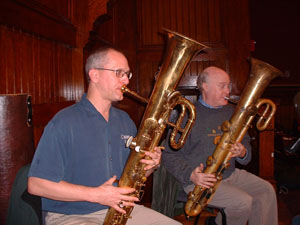 On November 22, 2007, Boston's Handel & Haydn Society, conducted by Jeffrey Rink, gave the first period instrument performance in
North America of the finale (fifth movement) of Berlioz's "Sinfonie Fantastique." The concert, at Harvard University's Sanders Theater, was
part of the Harvard course, "First Nights: Five Performance Premieres," led by Dr. Thomas Forrest Kelly. Taking the form of a lecture/recital,
Kelly brought the audience into Berlioz's sound, cultural and political world through spoken commentary and excerpts from the "Sinfonie" played
by the orchestra. Specially constructed tubular bells (at pitch A=430) were on hand and the audience was asked to vote on whether they preferred
the sound of the bells or that of two pianos which Berlioz suggested as a viable alternative to bells (the bells won in a lopsided vote).
The class concluded with a run-through of the entire movement.
On November 22, 2007, Boston's Handel & Haydn Society, conducted by Jeffrey Rink, gave the first period instrument performance in
North America of the finale (fifth movement) of Berlioz's "Sinfonie Fantastique." The concert, at Harvard University's Sanders Theater, was
part of the Harvard course, "First Nights: Five Performance Premieres," led by Dr. Thomas Forrest Kelly. Taking the form of a lecture/recital,
Kelly brought the audience into Berlioz's sound, cultural and political world through spoken commentary and excerpts from the "Sinfonie" played
by the orchestra. Specially constructed tubular bells (at pitch A=430) were on hand and the audience was asked to vote on whether they preferred
the sound of the bells or that of two pianos which Berlioz suggested as a viable alternative to bells (the bells won in a lopsided vote).
The class concluded with a run-through of the entire movement.
Jay Krush (of the Chestnut Brass Company) and I played ophicleide in the performance and I also played serpent in the opening statements of
the "Dies irae," following Berlioz's original intentions. During Kelly's lecture, I also came to the apron of the stage where I spoke a bit
on the history of the serpent and then played the "Dies irae" on serpent with a group of six male singers from Harvard, simulating performance
in a French church of the time. I played his Monk Workshop serpent (1996, London, walnut, 1 key) and Roehn ophicleide (c. 1855, Paris, in C,
9 keys) and Jay played his Butler and Son ophicleide (c. 1860, Soho, London, in C, 11 keys). It was a great pleasure to work once again with
Jay Krush, a tremendous person and musician, and to hear this movement of Berlioz's "Sinfonie" with period instruments (I had previously played
the fourth movement of the "Sinfonie" for the same class at Harvard in 2002) was enlightening.
-
October 23, 2006 - NEW
On June 10, 2006, I gave the
graduation address at the Caritas Academy of Arts and Sciences.
Titled "Hold On To Hope,"
it explores the theme of hope as we confront the challenges the world throws at us.
-
October 22, 2006 - NEW
 In 1906, the members of the Boston Symphony Orchestra Trombone Quartet (Carl Hampe, principal, August Mausebach, second,
Leroy Kenfield, bass, and another as yet unidentified player) traveled to the recording studios of the Victor Talking
Machine Company and recorded three pieces: "The Kerry Dance," "Annie Laurie," and "Nearer, My God, to Thee." "Annie Laurie"
was never released but the other two tracks enjoyed a long life in the Victor catalog.
In 1906, the members of the Boston Symphony Orchestra Trombone Quartet (Carl Hampe, principal, August Mausebach, second,
Leroy Kenfield, bass, and another as yet unidentified player) traveled to the recording studios of the Victor Talking
Machine Company and recorded three pieces: "The Kerry Dance," "Annie Laurie," and "Nearer, My God, to Thee." "Annie Laurie"
was never released but the other two tracks enjoyed a long life in the Victor catalog.
Trombonist Howard Knapp obtained copies of these recordings and when I was made aware of them, we learned that they are the
earliest known recordings by any group of players from the Boston Symphony Orchestra. These historical recordings caught the
attention of both the Boston Globe newspaper and Boston radio station WGBH. On October 21, the Boston Globe ran a
lengthy story about the recordings by Geoff Edgers on page one of its "Living/Arts" section and on October 22, I
was interviewed on WGBH radio when host Ron della Chiesa and I discussed the recordings and the players and the
recordings were aired, perhaps for the first time. All of this coincided nicely with the 125th anniversary of the
Boston Symphony which gave its first concert on October 22, 1881.
I have written a new article about these recordings,
The Boston Symphony Orchestra Trombone Quartet: The 1906 Victor Recordings which
includes many photos, archival documents from the Boston Symphony and BMG (Victor) archives, commentary and mp3
files of these important recordings. Research is ongoing and I expect to be updating this article from time to time
as we learn more about the recordings and the players who were part of making history as a result.
-
August 19, 2006 - UPDATE
Updated schedule page.
-
July 29, 2006 - NEW
In recent months I have been giving a great deal of thoughts to the Internet and email and how these technologies have changed our culture.
This new article, What Happened to the Internet?, is an expansion of these thoughts and a
discussion of how they are
leading me to make significant changes in my life.
-
July 13, 2006 - UPDATE
Updated schedule page.
-
June 10, 2006 - UPDATE
Updated schedule page.
-
May 25, 2006 - NEW
I have added photos of "The Henry Wadsworth Longfellow Memorial," by Daniel Chester French, located
at Longfellow Park, Cambridge, Massachusetts.
-
April 17, 2006 - UPDATE
Updated trombone humor page with a fantastic new parody
by David C. Fletcher on Salvador Dali's "The
Persistence of Memory" which he has titled, "The Persistence of Trombones."
-
April 2, 2006 - COMMENTARY


 Yesterday the
New England Brass Band
(NEBB), of which I am music director, competed at the 24th North American Brass Band Championships held on the campus of Indiana Unviersity Southeast in
New Albany, Indiana (across the river from Louisville, Kentucky). Sponsored by the
North American Brass Band Association, this year's contest was the fourth time the NEBB had particpated. In 2004, the NEBB took first place
in the "Challenge" section at NABBA XXII (see my commentary below for April 17, 2004, for my thoughts on that contest victory). This year, the band decided to move up to the "Honors" section which meant being in a more competitive section and having to play significantly
more difficult music. The test piece for the Honors section this year was Gilbert Vinter's "Spectrum" and we played Philip Sparke's "The Year of the Dragon" to fill out our contest program.
At the awards ceremony after the contest, we were thrilled to have our band announced as the winner of the Honors section. Running up to the stage to accept the trophy (the photo at
left shows my wife and me with the first place trophy) and banner (the photo at right shows me accepting the banner and trophy which was presented by NABBA President Anita
Cocker Hunt) was an unforgettable moment - looking out at our band members who were standing and cheering I could only think what a privilege it is to work
each week with such a talented and committed group of people. Brass banding, to me, represents the best of the amateur music world. Players getting together not for money but simply
to make music together. The NABBA contest is a special way for us to interact with people in other bands from around the country and to spend more time with our own band members as
we eat meals, travel and play together. Our hosts at Indiana University Southeast organized an excellent weekend which included a solo and small ensemble contest as well. NEBB Eflat
bass player Mark Fabulich won third place in the Adult Low Instrument Slow Melody solo contest and the band's flugelhorn player, Kevin Maloney, won third place in the Adult High
Instrument Slow Melody solo contest. In all it was a special weekend for all of us in the New England Brass Band and one which found the band growing musically and inter-personally.
Full results of the contest can be found on the
NABBA Music Resources Website and a full report about the contest can be found on the website of
4BarsRest.com.
Yesterday the
New England Brass Band
(NEBB), of which I am music director, competed at the 24th North American Brass Band Championships held on the campus of Indiana Unviersity Southeast in
New Albany, Indiana (across the river from Louisville, Kentucky). Sponsored by the
North American Brass Band Association, this year's contest was the fourth time the NEBB had particpated. In 2004, the NEBB took first place
in the "Challenge" section at NABBA XXII (see my commentary below for April 17, 2004, for my thoughts on that contest victory). This year, the band decided to move up to the "Honors" section which meant being in a more competitive section and having to play significantly
more difficult music. The test piece for the Honors section this year was Gilbert Vinter's "Spectrum" and we played Philip Sparke's "The Year of the Dragon" to fill out our contest program.
At the awards ceremony after the contest, we were thrilled to have our band announced as the winner of the Honors section. Running up to the stage to accept the trophy (the photo at
left shows my wife and me with the first place trophy) and banner (the photo at right shows me accepting the banner and trophy which was presented by NABBA President Anita
Cocker Hunt) was an unforgettable moment - looking out at our band members who were standing and cheering I could only think what a privilege it is to work
each week with such a talented and committed group of people. Brass banding, to me, represents the best of the amateur music world. Players getting together not for money but simply
to make music together. The NABBA contest is a special way for us to interact with people in other bands from around the country and to spend more time with our own band members as
we eat meals, travel and play together. Our hosts at Indiana University Southeast organized an excellent weekend which included a solo and small ensemble contest as well. NEBB Eflat
bass player Mark Fabulich won third place in the Adult Low Instrument Slow Melody solo contest and the band's flugelhorn player, Kevin Maloney, won third place in the Adult High
Instrument Slow Melody solo contest. In all it was a special weekend for all of us in the New England Brass Band and one which found the band growing musically and inter-personally.
Full results of the contest can be found on the
NABBA Music Resources Website and a full report about the contest can be found on the website of
4BarsRest.com.
To the members of the NEBB I am happy to say, once again, how proud I am of all of you and how fortunate I am to be the leader of a band full of such high quality individuals.
-
March 19, 2006 - NEW
 Brass Band Aid is an exciting partnership between brass bands worldwide which are working together with World Vision to construct and equip
a school in Adet, Ethopia. It has been inspiring to watch the progress of this noble effort as brass bands around the world, spearheaded by the Stanhope Band in England, have found
creative ways to engage audiences in rasing funds for the project. Recently, the board of directors of the New England Brass Band (of which I am music director) has voted to make a significant contribution to
Brass Band during the bands 2006-07 season. My wife and I are also making a personal donation to this effort. I have created a
new page on my website detailing the New England Brass Band's commitment to Brass Band Aid. Also provided are links to the Brass Band Aid website where more detailed information
about the Adet, Ethiopia project, the Brass Band Aid CD and how to make a donation to Brass Band Aid can be found. I hope many visitors to my website will learn more about Brass Band
Aid and consider ways they can become involved in this important charitable work.
Brass Band Aid is an exciting partnership between brass bands worldwide which are working together with World Vision to construct and equip
a school in Adet, Ethopia. It has been inspiring to watch the progress of this noble effort as brass bands around the world, spearheaded by the Stanhope Band in England, have found
creative ways to engage audiences in rasing funds for the project. Recently, the board of directors of the New England Brass Band (of which I am music director) has voted to make a significant contribution to
Brass Band during the bands 2006-07 season. My wife and I are also making a personal donation to this effort. I have created a
new page on my website detailing the New England Brass Band's commitment to Brass Band Aid. Also provided are links to the Brass Band Aid website where more detailed information
about the Adet, Ethiopia project, the Brass Band Aid CD and how to make a donation to Brass Band Aid can be found. I hope many visitors to my website will learn more about Brass Band
Aid and consider ways they can become involved in this important charitable work.
-
March 17, 2006 - EXHIBIT ANNOUNCEMENT
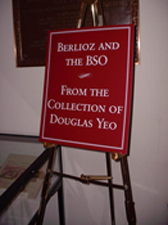
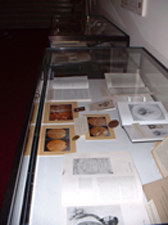
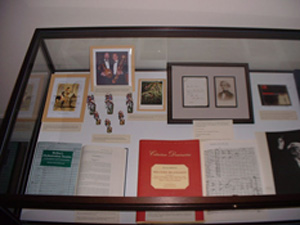 Reprinted from the Boston Symphony Orchestra Program Book, March 15 - May 6, 2006.
Reprinted from the Boston Symphony Orchestra Program Book, March 15 - May 6, 2006.
Celebrating Berlioz: A Special Display at Symphony Hall, Boston.
No single composer has been more closely identified with the Boston Symphony Orchestra than Hector Berlioz (1803-1869). Championed here in the past half-century particularly by Charles
Munch and Seiji Ozawa, Berlioz's music continues to figure prominently in the BSO's programming under James Levine, who led Berlioz's "Le Corsaire" Overture and "Symphonie fantastique"
earlier this season and has scheduled "La Damnation de Faust" for 2006-07. This April, guest conductor Rafael Frubeck de Burgos leads the composer's monumental Requiem. BSO bass trombonist
Douglas Yeo, a great admirer of Berlioz who has played trombone, serpent and ophicleide in Berlioz performances with the BSO and a number of period-instrument orchestras, has an extensive
collection of Berlioz memorabilia, books, and facsimile scores. The display cases in the Massachusetts Avenue corridor of Symphony Hall include a selection of items from Mr. Yeo's collection,
among them an original letter by Berlioz, commemorative medals struck for the Berlioz centennial in 1903, and photographs of the composer, as well as various facsimile scores that afford insight
into Berlioz's compositional process. The exhibit runs from March 15 - May 6, 2006.
-
March 9, 2006 - LINK
Among the many gifted and talented students I have had the privilege to teach is Matthew Guilford, bass trombonist of the National Symphony Orchestra in Washington D.C. Matt
was my first student at New England Conservatory of Music in Boston when I joined the Boston Symphony in 1985. Several weeks ago he asked if he could interview me and include that
interview on his website. I agreed and subsequently found his questions to be very thought provoking which led to my thinking very deeply about my answers. The interview is now online
on Matt's website, which can be found at matthewguilford.com.
-
February 12, 2006 - COMMENTARY
 Last week I travelled to Texas for a week long masterclass tour of five universities. I have given hundreds of similar classes over the years in schools around the world but this
trip to Texas was particularly rewarding for me in many ways. Dennis Bubert, bass trombonist of the Fort Worth Symphony and professor of trombone at University of Texas Arlington
organized the trip for me which was several years in the planning. I appreciate, too, Yamaha's sponsorship of several of the classes.
Thanks to the Boston Symphony Orchestra scheduling a week of all-Beethoven concerts, I was able to get down
to Texas for five days where I was hosted at five schools by tremendously gifted trombone professors. Dennis Bubert, Nathaniel Brickens (University of Texas Austin), Henry
Howey (Sam Houston State), Brian Kauk (University of Houston) and Wayne Dyess (Lamar University) all were gracious hosts who preside over studios of gifted, interested
and interesting trombonists. The classes at each school showed each group of players to be unique in many ways but bound together with a common purpose to bring
excellence to music making. It was also gratifying to find many high school students, music teachers and parents in the audiences as we journeyed together by talking, playing, and
interacting. In Arlington, I was pleased to find several former students who had studied with me at New England Conservatory in the audience. My drivers, Dennis Bubert,
Brian Kauk and David Ford (of Music & Arts Centers in Houston) provided me with many hours of interesting and stimulating conversation as we navigated the considerable distances we had
to travel over east Texas. I find it especially gratifying to meet people with whom I have interacted over the years through the Internet, either by email or through the Online
Trombone Journal Forum or the basstrombone.nl forum. On this trip I was able to put many names with faces and voices, and meeting Wayne Dyess (who had helped me by mastering
old tapes and LP cuts for my CD "Take 1") was a special pleasure. I came home to Boston with many thoughts and memories of young trombone players, fine food (barbeque, Mexican and
Cajun cuisine - the fried alligator in Beaumont, steak in Fort Worth and Mexican style talapia in Huntsville were especially memorable - as was the home town barbeque in Huntsville
where the restaurant's motto was, "Our beans speak for themselves...") and a new pair of cowboy boots. Leaving the balmy temperatures of Texas to be confronted with a major
blizzard (18 inches of snow has arrived today in Boston) is quite a contrast. To all who made my trip such a success (including my younger brother, Greg, and his wife who
I got to see during the week), I offer my profound thanks. And to the students I worked with
and who were in the audiences, keep the standard in mind as you strive for excellence. Sempre avanti!
Last week I travelled to Texas for a week long masterclass tour of five universities. I have given hundreds of similar classes over the years in schools around the world but this
trip to Texas was particularly rewarding for me in many ways. Dennis Bubert, bass trombonist of the Fort Worth Symphony and professor of trombone at University of Texas Arlington
organized the trip for me which was several years in the planning. I appreciate, too, Yamaha's sponsorship of several of the classes.
Thanks to the Boston Symphony Orchestra scheduling a week of all-Beethoven concerts, I was able to get down
to Texas for five days where I was hosted at five schools by tremendously gifted trombone professors. Dennis Bubert, Nathaniel Brickens (University of Texas Austin), Henry
Howey (Sam Houston State), Brian Kauk (University of Houston) and Wayne Dyess (Lamar University) all were gracious hosts who preside over studios of gifted, interested
and interesting trombonists. The classes at each school showed each group of players to be unique in many ways but bound together with a common purpose to bring
excellence to music making. It was also gratifying to find many high school students, music teachers and parents in the audiences as we journeyed together by talking, playing, and
interacting. In Arlington, I was pleased to find several former students who had studied with me at New England Conservatory in the audience. My drivers, Dennis Bubert,
Brian Kauk and David Ford (of Music & Arts Centers in Houston) provided me with many hours of interesting and stimulating conversation as we navigated the considerable distances we had
to travel over east Texas. I find it especially gratifying to meet people with whom I have interacted over the years through the Internet, either by email or through the Online
Trombone Journal Forum or the basstrombone.nl forum. On this trip I was able to put many names with faces and voices, and meeting Wayne Dyess (who had helped me by mastering
old tapes and LP cuts for my CD "Take 1") was a special pleasure. I came home to Boston with many thoughts and memories of young trombone players, fine food (barbeque, Mexican and
Cajun cuisine - the fried alligator in Beaumont, steak in Fort Worth and Mexican style talapia in Huntsville were especially memorable - as was the home town barbeque in Huntsville
where the restaurant's motto was, "Our beans speak for themselves...") and a new pair of cowboy boots. Leaving the balmy temperatures of Texas to be confronted with a major
blizzard (18 inches of snow has arrived today in Boston) is quite a contrast. To all who made my trip such a success (including my younger brother, Greg, and his wife who
I got to see during the week), I offer my profound thanks. And to the students I worked with
and who were in the audiences, keep the standard in mind as you strive for excellence. Sempre avanti!
-
January 31, 2006 - NEW
Added a new page detailing the history of yeodoug.com in
celebration of the 10th birthday of my website on February 12, 2006.
-
January 26, 2006 - UPDATE
Updated schedule page with more information about my masterclasses in Texas in February and in Louisville, Kentucky, in March.
-
January 13, 2006 - NEW
Added a new page, P.D.Q. Bach and the American Serpent Players with photos and commentary about three concerts
I played in New York City with the American Serpent Players and Professor Peter Schickele. At these concerts ASP performed P.D.Q. Bach's round, "O, Serpent" as part
of Schickele's "40 Year Retrogressive" of the music of P.D.Q. Bach.
-
January 11, 2006 - UPDATE
Updated my Trombones and related instruments gallery page with a photo of August Helleberg holding
his Conn BBflat contrabass trombone which I now have in my collection and an additional photo of Edward Williams, bass trombonist of the Sousa Band who played
the same model Conn "New Invention" bass trombone that I now have.
-
January 3, 2006 - UPDATE
Updated Serpentists at Amiens Cathedral (France) with new scans and commentary of Charles Wild's
c.1826 engraving/aquatint that has major implications on how we view ecclesiastical musicin France in the early 19th century. Also updated my
schedule page with information about my planned master class tour of Texas to take place in February.
resources/amiens/amiens.html
-
December 31, 2005 - UPDATE
Updated the home page to announce that on February 12, yeodoug.com will celebrate 10 years on the Internet. On February 1, I will
announce a special "thank you offer" for visiters to my website in thanks for their support over these many years.
-
December 29, 2005 - COMMENTARY
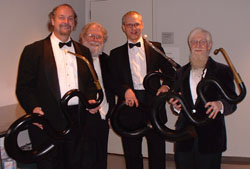 Today I concluded a most satisfying run of concerts. As a member of the American Serpent Trio (which in addition to myself includes Craig Kridel and
Steve Silverstein), I played in three concerts hosted by Professor Peter Schickele. "P.D.Q. Bach: a 40-Year Retrogressive" was held in Symphony Space in New York City
to three sold out houses on December 27-29. I was first introduced to the music of P.D.Q. Bach over 30 years ago and for several years in the mid-70s, my wife and I attended
the annual P.D.Q. Bach concerts between Christmas and the New Year at Carnegie Hall. Never in my wildest imagination did I ever dream I would take part in some of Peter
Schickele's musical mayhem. As part of the concert, the American Serpent Players (ASP) played P.D.Q. Bach's round, "O, Serpent" for serpent trio and singers. We also performed
an encore at the end of the concert, Seiber's "Foxtrot" which I recorded with Craig Kridel and Phil Humphries on my CD, "Le Monde du Serpent." It was not lost on us that
the middle of the three concerts took place on the birthday of Christopher Monk, the leader of the modern revival of the serpent who passed away in 1991. The audience's
reception was wildly enthusiastic toward the serpent and its players and the photo at left shows, from left to right, Craig Kridel, Peter Schickele, myself and Steve Silverstein.
If you have not heard the music of P.D.Q. Bach, you owe it to yourself to get to know more about him. Visit
Peter Schickele's Website for an introduction to this most remarkable musician. What a wonderful way to conclude the year and
move into 2006. On January 12, I added a new page on my website, P.D.Q. Bach and the American Serpent Players
which contains many photos and some commentary about these concerts.
Today I concluded a most satisfying run of concerts. As a member of the American Serpent Trio (which in addition to myself includes Craig Kridel and
Steve Silverstein), I played in three concerts hosted by Professor Peter Schickele. "P.D.Q. Bach: a 40-Year Retrogressive" was held in Symphony Space in New York City
to three sold out houses on December 27-29. I was first introduced to the music of P.D.Q. Bach over 30 years ago and for several years in the mid-70s, my wife and I attended
the annual P.D.Q. Bach concerts between Christmas and the New Year at Carnegie Hall. Never in my wildest imagination did I ever dream I would take part in some of Peter
Schickele's musical mayhem. As part of the concert, the American Serpent Players (ASP) played P.D.Q. Bach's round, "O, Serpent" for serpent trio and singers. We also performed
an encore at the end of the concert, Seiber's "Foxtrot" which I recorded with Craig Kridel and Phil Humphries on my CD, "Le Monde du Serpent." It was not lost on us that
the middle of the three concerts took place on the birthday of Christopher Monk, the leader of the modern revival of the serpent who passed away in 1991. The audience's
reception was wildly enthusiastic toward the serpent and its players and the photo at left shows, from left to right, Craig Kridel, Peter Schickele, myself and Steve Silverstein.
If you have not heard the music of P.D.Q. Bach, you owe it to yourself to get to know more about him. Visit
Peter Schickele's Website for an introduction to this most remarkable musician. What a wonderful way to conclude the year and
move into 2006. On January 12, I added a new page on my website, P.D.Q. Bach and the American Serpent Players
which contains many photos and some commentary about these concerts.
-
December 18, 2005 - UPDATE
Updated schedule page.
-
December 1, 2005 - NEW
 In June of this year, I participated in the Yamaha Trombone Day at the Yamaha Artist Services Inc. (YASI) in New York City (see the entry on this page for June 19, 2005.
Yamaha has now released a FREE recording of the recital given at the event by the Yamaha Xeno Trombone Quartet (Peter Sullivan, Al Kay, Tom Brantley and me).
The concert included solos by each of the Quartet members as well as several trombone quartets with a mixture of classical and jazz selections. Part 1 of the concert is available
now; part 2 will be available on December 13. For more information about Yamaha podcasts and details on how to download the Yamaha Xeno Trombone Quartet podcast to your
computer and iPod, visit the
Yamaha Podcast Page.
In June of this year, I participated in the Yamaha Trombone Day at the Yamaha Artist Services Inc. (YASI) in New York City (see the entry on this page for June 19, 2005.
Yamaha has now released a FREE recording of the recital given at the event by the Yamaha Xeno Trombone Quartet (Peter Sullivan, Al Kay, Tom Brantley and me).
The concert included solos by each of the Quartet members as well as several trombone quartets with a mixture of classical and jazz selections. Part 1 of the concert is available
now; part 2 will be available on December 13. For more information about Yamaha podcasts and details on how to download the Yamaha Xeno Trombone Quartet podcast to your
computer and iPod, visit the
Yamaha Podcast Page.
-
November 14, 2005 - NEW
Added new free pdf downloads of movements of my Bach Cello Suites performing edition for trombone including Suite 1:
Prelude and Gigue and Suite 2: Courante, Sarabande and Menuet I & II.
-
November 12, 2005 - NEW
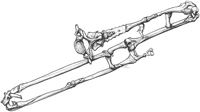 I have added a new page to my website devoted to The Visual Art of Don Stewart . Don is an artist with a keen eye for creating something new out of
something old. His "composite" images fascinate me, and my page about Don and his work includes several samples of his work including his "Trombones" "Medusa" (a
drawing based on historical brass instruments including serpent, buccin, bass horn, cornetto and much more) and "Show Horns." These are extrardinily creative and
interesting images ("Shoe Horns" is one of those things that just knocks you over as soon as you lay eyes on it) and I have become a big fan and supporter of
Don's work. Don's drawings make for great gifts and are
sure to make you smile.
I have added a new page to my website devoted to The Visual Art of Don Stewart . Don is an artist with a keen eye for creating something new out of
something old. His "composite" images fascinate me, and my page about Don and his work includes several samples of his work including his "Trombones" "Medusa" (a
drawing based on historical brass instruments including serpent, buccin, bass horn, cornetto and much more) and "Show Horns." These are extrardinily creative and
interesting images ("Shoe Horns" is one of those things that just knocks you over as soon as you lay eyes on it) and I have become a big fan and supporter of
Don's work. Don's drawings make for great gifts and are
sure to make you smile.
-
October 30, 2005 - NEW
Peter Ryan produces a weekly podcast devoted to brass bands. On October 30, he uploaded a new podcast which features tracks
of me playing bass trombone solos with brass band including excerpts from my solo CDs "Proclamation" and "Two of a Mind" as well as a solo
track from the New England Brass Band's CD "The Light of the World." The podcast also includes a brief interview with me.
This podcast is FREE and available at
brasscast.com.
-
October 23, 2005 - UPDATE
Updated Daniel Chester French: Sculpture in Situ page with links to other sites that feature French's work
as well as sites that discuss the tragic and influential life of Audrey Munson who served as a model for many of French's sculptures.
-
October 19, 2005 - COMMENTARY
This evening I participated in a live Internet "chat" hosted by the excellent website
MyAuditions.com . This was my first such event and I found both the technology and the process to be fascinating.
I was also impressed with the excellent questions people asked me and how I could use this real-time Internet format to communicate with people from around the world.
MyAuditions.com come has also posted the
transcript of my "chat" which some readers might find interesting or helpful.
-
October 8, 2005 - UPDATE
Updated my Trombones and related instruments gallery page with photos of many more instruments
in my collection including my c. 1830 buccin by Sautermeister, two trombones previously owned by Joannes Rochut, a 1938 Boosey and Hawkes G bass trombone,
a bass sackbut in F made by Frank Tomes and the Yamaha YSL-350C compact trombone.
-
October 8, 2005 - UPDATE
Updated schedule page and did a major update and reorganization of my
links page.
-
September 20, 2005 - NEW
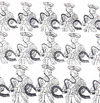 I live a very interesting musical life and one of the joys of recent years has been my involvement with historical brasses, in particular the serpent.
Earlier this year I went to Lily Bay Studios in Wayland, Massachusetts (run by my Boston Symphony Orchestra horn colleague, Richard Sebring) to
embark on an interesting project with the serpent: a performance of Clifford Bevan's arrangement of Tchaikovsky's "1812 Overture" arranged for
serpent ensemble with all of the serpent parts played by me, myself and I. I wanted to record this arrangement, which was given its premiere at the 1990 serpent
celebration at St. John's Smith Square in London (an event which celebrated the 400th anniversary of the invention of the serpent) as a thank you gift
to Cliff Bevan in thanks for all he has done for the serpent and how his music and scholarship has enriched my life. While I was delighted that Cliff
was happy with my performance, I was even more pleased when he suggested we make it available to people to hear for free as a download on my website.
If you're interested in the sound of 26 serpents playing together in ensemble (complete with church bells and cannon) and would like to know more about
the history of this arrangement (I have posted photos of rehearsals of the premiere of the arrangement that included 56 serpent players), visit my
1812 Overture free mp3 download page.
I live a very interesting musical life and one of the joys of recent years has been my involvement with historical brasses, in particular the serpent.
Earlier this year I went to Lily Bay Studios in Wayland, Massachusetts (run by my Boston Symphony Orchestra horn colleague, Richard Sebring) to
embark on an interesting project with the serpent: a performance of Clifford Bevan's arrangement of Tchaikovsky's "1812 Overture" arranged for
serpent ensemble with all of the serpent parts played by me, myself and I. I wanted to record this arrangement, which was given its premiere at the 1990 serpent
celebration at St. John's Smith Square in London (an event which celebrated the 400th anniversary of the invention of the serpent) as a thank you gift
to Cliff Bevan in thanks for all he has done for the serpent and how his music and scholarship has enriched my life. While I was delighted that Cliff
was happy with my performance, I was even more pleased when he suggested we make it available to people to hear for free as a download on my website.
If you're interested in the sound of 26 serpents playing together in ensemble (complete with church bells and cannon) and would like to know more about
the history of this arrangement (I have posted photos of rehearsals of the premiere of the arrangement that included 56 serpent players), visit my
1812 Overture free mp3 download page.
-
August 23, 2005 - UPDATE
I have updated my schedule page with many concerts and other activities for the
2005-06 season including concerts with the New England Brass Band, the Handel & Haydn Society, tour concerts with the Boston Symphony,
and an online "Celebrity Internet Chat" hosted by myauditions.com.
-
August 11, 2005 - UPDATE
I have uploaded a new photo of a beautifully restored English military serpent
by Francis Pretty (now owned by Nick Parkes) with commentary to my Serpent Photo Gallery.
-
June 19, 2005 - COMMENTARY
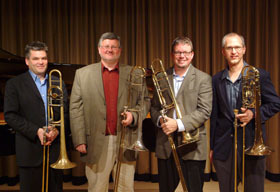 This weekend I had the great pleasure of participating in a Yamaha sponsored "Trombone Day" in New York City. Yesterday's day long event was held at the new
Yamaha Artist Services facility on Fifth Avenue. The day was a happy reunion for the members of the Yamaha Xeno Trombone Quartet that was formed in 2004
for a performance at the 2004 International Trombone Festival in Ithaca, New York. Tenor trombonists Pete Sullivan (principal trombonist, Pittsburgh Symphony),
Al Kay (Canadian jazz artist), Tom Brantley (professor of trombone at University of South Florida and member of "Rhythm and Brass") and I make up the Xeno
quartet; each of us play the latest model Yamaha Xeno trombones. The Trombone Day consisted of clinics given by Pete, Al and me and then an evening recital of solos
and trombone quartets. Throughout the day the full line of Yamaha trombones were available for people to try out. I thoroughly enjoyed my time interacting with
many people through the day; it was a wonderful surprise to see some former students there who I had not seen in several years as well as New York players who
I had not had contact with since my days as a free lance player in New York many years ago (1976-1981). Yamaha is working to put some of our recital online
on the Yamaha website and when that happens, I'll post an update here so people who are interested can hear some of that playing. To hear Al Kay play "Csardas" is
truly something to behold! For more information about Yamaha trombones, visit the
Yamaha Band Instrument Website.
This weekend I had the great pleasure of participating in a Yamaha sponsored "Trombone Day" in New York City. Yesterday's day long event was held at the new
Yamaha Artist Services facility on Fifth Avenue. The day was a happy reunion for the members of the Yamaha Xeno Trombone Quartet that was formed in 2004
for a performance at the 2004 International Trombone Festival in Ithaca, New York. Tenor trombonists Pete Sullivan (principal trombonist, Pittsburgh Symphony),
Al Kay (Canadian jazz artist), Tom Brantley (professor of trombone at University of South Florida and member of "Rhythm and Brass") and I make up the Xeno
quartet; each of us play the latest model Yamaha Xeno trombones. The Trombone Day consisted of clinics given by Pete, Al and me and then an evening recital of solos
and trombone quartets. Throughout the day the full line of Yamaha trombones were available for people to try out. I thoroughly enjoyed my time interacting with
many people through the day; it was a wonderful surprise to see some former students there who I had not seen in several years as well as New York players who
I had not had contact with since my days as a free lance player in New York many years ago (1976-1981). Yamaha is working to put some of our recital online
on the Yamaha website and when that happens, I'll post an update here so people who are interested can hear some of that playing. To hear Al Kay play "Csardas" is
truly something to behold! For more information about Yamaha trombones, visit the
Yamaha Band Instrument Website.
-
May 25, 2005 - UPDATE
I have made some significant updates to my articles Pursuing a Career in Orchestral Music,
Symphony Auditions: Preparation and Execution, and
my page of music links.
-
April 24, 2005 - NEW
I have added photos of "Spirit of the Waters," by Daniel Chester French, located
at the Fogg Art Museum, Cambridge, Massachusetts.
-
April 23, 2005 - NEW
I have added photos of "Chesterwood," the summer home and studio of Daniel Chester French, located
in Stockbridge, Massachusetts.
-
April 23, 2005 - UPDATE
Updated schedule page.
-
April 19, 2005 - NEW
I have added photos of the statue of "The Republic" by Daniel Chester French which is found
in Jackson Park in Chicago, Illionis.
-
April 5, 2005 - COMMENTARY
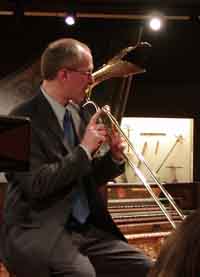 Yesterday I had the great pleasure of giving a lunchtime talk about the trombone at the
Boston Museum of Fine Arts . I have been giving talks at the Museum over the past several
years, and I have also enjoyed giving talks and demonstrations at other museums around the country including the National Music Museum in South Dakota and
the Metropolitan Museum of Art in New York City. After having given several talks about the serpent and ophicleide, it was nice to return to the MFA to
explore my primary instrument, the trombone. The MFA's collection of trombones is rather small but they have some important instruments that I was able to
discuss and demonstrate including a 1781 soprano trombone by Schmied, a fine Belgian back facing tenor trombone and a buccin by Tabard with a painted zoomorphic
head and flapping metal tongue.
Yesterday I had the great pleasure of giving a lunchtime talk about the trombone at the
Boston Museum of Fine Arts . I have been giving talks at the Museum over the past several
years, and I have also enjoyed giving talks and demonstrations at other museums around the country including the National Music Museum in South Dakota and
the Metropolitan Museum of Art in New York City. After having given several talks about the serpent and ophicleide, it was nice to return to the MFA to
explore my primary instrument, the trombone. The MFA's collection of trombones is rather small but they have some important instruments that I was able to
discuss and demonstrate including a 1781 soprano trombone by Schmied, a fine Belgian back facing tenor trombone and a buccin by Tabard with a painted zoomorphic
head and flapping metal tongue.
In addition to the Museums's trombones, I brought along a few of my own instruments to show the evolution of the trombone through
the ages including a bass sackbut by Frank Tomes, my BB flat Conn contrabass trombone made in 1903, my Conn "Preacher Model" tenor trombone in Bflat/C made in 1923
and my newly acquired Sautermeister buccin which I'm shown talking about in the photo at left.
Later this week I will continue my ongoing exploration of historical brasses when I play serpent in a performance of the Divertimento in B flat (St Antoni Chorale) which is
attributed to Haydn. This will be in performance with Boston's Handel & Haydn Society at Symphony Hall, Boston, in a small chamber music group of players with historical
instruments. While I recorded this piece on my CD "Le Monde du Serpent" this will be the first time I will have played it on original instruments including natural horns. Our
performance will open the Handel & Haydn concerts this weekend which will follow with two works by Brahms: his "Variations on a Theme of Haydn" (which is based on the
"St Antoni Chorale" of the Divertimento and his "Ein Deutsches Requiem." To move from early trombones to serpent in chamber music with a week of Boston Symphony Youth
Concerts inbetween (all of which include the main title theme from "Star Wars") is to be a part of a very rich musical life!
-
April 2, 2005 - COMMENTARY
Pope John Paul II died today. While I do not share the Roman Catholic faith, I am a Christian and one who has had great admiration for this remarkable man of God who has now
moved from this life to the next.
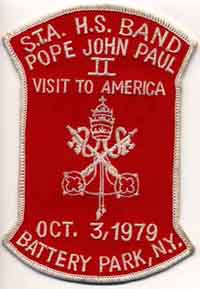 From 1979-1981, I was director of bands at
St. Thomas Aquinas (now Bishop George Ahr) High School
in Edison, New Jersey. My job at STA was my first full time music position. After
graduation from Wheaton College (Illinois) my wife and I moved to New York City where I was a freelance bass trombonist and also worked various office jobs while pursuing my
master's degree at New York University. I applied for the STA position in the summer of 1979 and I began the job that fall.
From 1979-1981, I was director of bands at
St. Thomas Aquinas (now Bishop George Ahr) High School
in Edison, New Jersey. My job at STA was my first full time music position. After
graduation from Wheaton College (Illinois) my wife and I moved to New York City where I was a freelance bass trombonist and also worked various office jobs while pursuing my
master's degree at New York University. I applied for the STA position in the summer of 1979 and I began the job that fall.
St. Thomas Aquinas High School was staffed by Felician Sisters, an order that had its origin in Poland. You can imagine my thoughts when I was told, during my first week on the job,
that our High School band had been selected to play for Pope John Paul II when he was to visit New York City in October, 1979. We were chosen as one of two bands from New Jersey
to play for the Pope and being a school with Polish connections, the school was nearly turned upside down with the news. On a personal level this was exciting, but it was made even
more so because my wife was, at that time, pregnant and imminently ready to give birth to our first child. In the weeks preceding the Pope's visit, I arranged music for our
performance (which would be in Battery Park at the southern tip of Manhattan in New York City; we played a number of Polish folk songs and hymns in addition to some other music)
but also found myself in the midst of a "human interest" news story about the timing of the visit and how it related to my wife's pregnancy.
October 3, 1979 dawned cloudy and rain fell during our trip into New York. As we all waited for the Pope to arrive, we played and played - in the rain - wearing ponchos and getting
absolutely soaked. Yet when the Pope arrived, the rain stopped as if we were witnessing something that could only come out of a Hollywood epic film, the sun came out, and he smiled
and waved at the students in our band who were standing in awe only 50 feet from him.
It was a great moment as we were part of history: Pope John Paul II, along with President Ronald Reagan, is credited with being a significant force in the defeat of communism in
the USSR and eastern Europe. He was an author, teacher and leader whose legacy will be felt for years to come. More than anything he was a servant of Christ and he did not shy away
from preaching the Gospel with clarity and authority. His connection with our family will always be a strong one for many reasons, not the least of which is because
the day after our band played for him, my wife gave birth to our first daughter who became a bit of a celebrity as a result of the timing of her coming into the world. At St. Thomas
Aquinas High School, she was always known as "The Pope's Baby" and her baby book is full of clippings and articles that celebrated the birth of a daughter to the band director and
his wife who nervously got through the events of October 3 as Divine Providence delayed a birth until the work was done. (Newspaper
headlines about the story read, "Pope, Paternity Arrive for Aquinas Band Director" and "Delayed Birth Linked to Divine Providence" and the biggest understatement of
all, "What a Week for the Yeos". ) My time at St. Thomas Aquinas was very influential on my musical and spiritual life and I will
always look back ton that time with fondness. Father Michael Alliegro, Sister Mary Seraphica, John Kronemeyer and, of course, the students, all have been a part of my life
over the last 25+ years. The patch shown here was something I had made for all of the
students who played at Battery Park that day in 1979 - 55 were made and I took mine out of a drawer today and I share it with you in tribute to a great and Godly man who has left a changed
world behind him. Requiem aeterna dona eis.
-
March 16, 2005 - COMMENTARY
 Those who know me well know of my interest in old instruments, particularly the French bass brasses of the early and mid 19th century including serpent and ophicleide. I
have played these instruments for over 10 years (among my serpents is one by Baudouin, Paris c. 1812 and an ophicleide by Roehn, Paris c. 1855) and they have given
me no end of pleasure.
Those who know me well know of my interest in old instruments, particularly the French bass brasses of the early and mid 19th century including serpent and ophicleide. I
have played these instruments for over 10 years (among my serpents is one by Baudouin, Paris c. 1812 and an ophicleide by Roehn, Paris c. 1855) and they have given
me no end of pleasure.
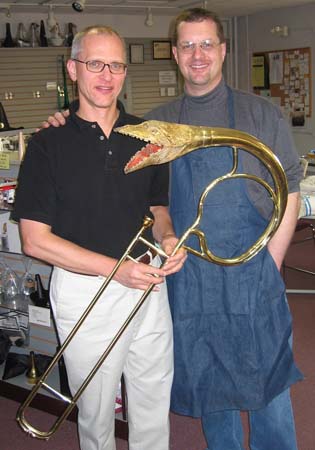 Since I was a young boy I have always wanted a buccin, the early 19th century French form of trombone with a zoomorphic head. I remember in the mid 1960's going to the
Metropolitan Museum of Art in New York City and standing (and staring) in front of a display case with three buccins that just held me transfixed. When I recorded my
CD Le Monde du Serpent, Berlioz Historical Brass commissioned a new piece from Clifford Bevan, "Le Mots de Berlioz" for choir with buccin, ophicleide, serpent and
bassoon. It was the first time I had ever actually HEARD a buccin (played beautifully by Ben Peck who used a modern reproduction made by John Webb). I knew right then I
simply had to get one to play myself.
Since I was a young boy I have always wanted a buccin, the early 19th century French form of trombone with a zoomorphic head. I remember in the mid 1960's going to the
Metropolitan Museum of Art in New York City and standing (and staring) in front of a display case with three buccins that just held me transfixed. When I recorded my
CD Le Monde du Serpent, Berlioz Historical Brass commissioned a new piece from Clifford Bevan, "Le Mots de Berlioz" for choir with buccin, ophicleide, serpent and
bassoon. It was the first time I had ever actually HEARD a buccin (played beautifully by Ben Peck who used a modern reproduction made by John Webb). I knew right then I
simply had to get one to play myself.
Last summer I acquired a buccin bell from a dealer in Paris with the goal of having it restored and be played. The bell is by Sautermeister, a maker in Lyon (France) who
was active from 1809-1830. Original buccin slides are usually in dreadful condition so I decided to have a new slide made after an historical model. The bell restoration was
carried out by Jim Becker of Osmun Music (www.osmun.com) in Arlington, Massachusetts. The photo at right shows Jim Becker and me
in the Osmun Music shop with the restored buccin. The bell needed considerable work to be put into good condition and Jim used
a combination of his vast experience and some creative solutions to return the bell to playing order. He then made an entirely new hand slide after the buccin slide on an instrument
(by Tabard) in Boston's Museum of Fine Arts. Jim put a tuning slide at the end of the slide so the instrument can be played at low pitch and Naoki Tada of the Yamaha
Custom Shop (Hamamatsu, Japan) made a spectacular slide crook with two intertwined serpents. Today everything came together and the instrument was completed - I picked it
up and have already had a great deal of pleasure playing it. It has a funky overtone series because of the oddly shaped bell (which is made of very thin brass), but the sound is mellow and
sweet when played at soft dynamics and strong and firm (without being edgy) when played loudly.
The photo above (left) shows me playing my buccin while standing in front of a display case at Symphony Hall in Boston that includes several instruments from the Casadeasus Collection, a
collection of early instruments owned by the Boston Symphony. Shown on the left is a form of upright serpent called a "basson Russe" that also has a zoomorphic head.
Once again, I offer encouragement to those who are interested in playing older instruments. Doing so gives an interesting perspective on our modern instruments and
transports us back to an earlier time when the evolution of musical instruments was still very much active. Breathing new life into an instrument that has been silent for
perhaps over 150 years is a rare feeling.
-
March 15, 2005 - UPDATE
Updated all site headers with a new photo. This was long overdue; the previous photo, by Steven Emery, had been taken in 1994. The new photo, by Betsy Bassett, was taken
in 2004 and reflects the more current reality.
-
February 28, 2005 - COMMENTARY
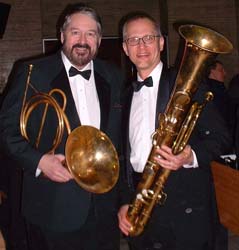 This past weekend I had the great pleasure of playing ophicleide in a performance of Berlioz's "Romeo et Juliette," his great symphony based on Shakespeare's play.
The performance, with Boston's Chorus Pro Musica (Jeffrey Rink, conductor) and an orchestra of players from Boston and around the country, was the first known
performance of "Romeo" in North America on period instruments, that is utilizing instruments that would have been used in Berlioz's time. I had performed "Romeo" with the Boston Symphony
Orchestra under the direction of music director James Levine last fall. At that time, I played third trombone (using a tenor trombone as I always do when playing Berlioz, as
he wrote almost exclusively for a trombone section of three tenor trombones). This performance took me to a completely different sound world. The trombone section (Robert
Couture, Hans Bohn and Mark Cantrell) all used very small bore tenor trombones. The horn players were using natural horns (no valves); the photo at left is of Lowell Greer,
one of the world's leading natural horn experts, with me. Two cornets played alongside two natural trumpets. Four small bore bassoons, early wooden flutes and clarinets,
classical string instrument bows. The resulting experience was a thrill for me. The beautiful, rough and smooth (all at the same time) sound of these instruments gave me
a new perspective on Berlioz, one of my most beloved composers. With early instruments, you wrestle and contend more intimately with your horn - it is not a perfect,
modern construction. Yet, the added concentration and work (sometimes with unexpected results) yields even greater rewards.
This past weekend I had the great pleasure of playing ophicleide in a performance of Berlioz's "Romeo et Juliette," his great symphony based on Shakespeare's play.
The performance, with Boston's Chorus Pro Musica (Jeffrey Rink, conductor) and an orchestra of players from Boston and around the country, was the first known
performance of "Romeo" in North America on period instruments, that is utilizing instruments that would have been used in Berlioz's time. I had performed "Romeo" with the Boston Symphony
Orchestra under the direction of music director James Levine last fall. At that time, I played third trombone (using a tenor trombone as I always do when playing Berlioz, as
he wrote almost exclusively for a trombone section of three tenor trombones). This performance took me to a completely different sound world. The trombone section (Robert
Couture, Hans Bohn and Mark Cantrell) all used very small bore tenor trombones. The horn players were using natural horns (no valves); the photo at left is of Lowell Greer,
one of the world's leading natural horn experts, with me. Two cornets played alongside two natural trumpets. Four small bore bassoons, early wooden flutes and clarinets,
classical string instrument bows. The resulting experience was a thrill for me. The beautiful, rough and smooth (all at the same time) sound of these instruments gave me
a new perspective on Berlioz, one of my most beloved composers. With early instruments, you wrestle and contend more intimately with your horn - it is not a perfect,
modern construction. Yet, the added concentration and work (sometimes with unexpected results) yields even greater rewards.
For instance, trombonists are well acquainted with the opening introduction of "Romeo," an extended recitative for the low brass. What most trombonists don't know (or don't consider) is that
Berlioz includes the horns in that passage, but, because the horns are natural and not fully chromatic, the composer assigns one note of the passage to each horn in its
corresponding key. The effect for the horns is a bit of musical "ping-pong" not unlike a handbell choir where each player is responsible for only a few notes of the melody.
With this in mind, the balance was adjusted so the trombones and ophicleide did not dominate, rather the horns became an integral part of the texture. It is things like this that
make music with these early instruments so interesting. While there certainly is dogmatism in the early music movement (a classic example of the oppressed becoming the
oppressors), I have found working with early music players to be very stimulating - players bring in and talk about different instruments, makers, the ubiquitous issue of
the tuning pitch, horn construction, performance practice and, above all, the music. It is refreshing and enjoyable to a high degree. My life in early music continues to grow and
expand, from serpent to ophileide to buccin (the type of trombone developed in France in the late 18th century with a zoomorphic head). This weekend's performance of "Romeo"
was yet another step along the way as I put myself back in time to consider the role of instruments, musicians and music upon a time long past. There are more adventures
on the way, including a presentation at Boston's Museum of Fine Arts in April where I will discuss and demonstrate various types of trombones, and, also in April, a performance
on serpent with Boston's Handel & Haydn Orchestra. June will bring me to the Great American Brass Band Festival where I will give a paper on serpent an dophicleide soloists
and then perform a solo on ophicleide accompanied by a brass band. For those interested in these and other performances I have upcoming, visit my schedule page.
-
February 6, 2005 - COMMENTARY
 What a day for sports fans in New England. The New England Patriots are the National Football League's Super Bowl XXXIX champions after defeating the Philadelphia
Eagles, 24-21. With this victory, the Patriots have won three of the last four Super Bowls, a stunning accomplishment. It was another exciting day in our
house, decorated with Patriots and Super Bowl items and cheering our team on to victory. This season, my wife and I went to four Patriots games at Gillette Stadium
(games against the Buffalo Bills, Miami Dolphins, Baltimore Ravens and the playoff game against the Indianapolis Colts - all victories). As I've mentioned several times on my website,
I attended Super Bowl XXXVI in New Orleans and with each year it grows as one of the most fantastic experiences of my life. As a member of the Boston Pops Orchestra,
I played in the pre-game show to that game and then enjoyed the game courtesy of a ticket given to
me (and other members of the orchestra) by Patriots owner Robert Kraft, a man who surely is one of the greatest owners of a sports team in the world. At the time
of Super Bowl XXXVI I kept a daily diary of the preparations of the Boston Pops Orchestra as well as my own feelings at that thrilling time. For those interested,
that diary (with many color photos) is still available for viewing on my website; see
The New England Patriots and the Boston Pops: A Super Bowl XXXVI Diary.
What a day for sports fans in New England. The New England Patriots are the National Football League's Super Bowl XXXIX champions after defeating the Philadelphia
Eagles, 24-21. With this victory, the Patriots have won three of the last four Super Bowls, a stunning accomplishment. It was another exciting day in our
house, decorated with Patriots and Super Bowl items and cheering our team on to victory. This season, my wife and I went to four Patriots games at Gillette Stadium
(games against the Buffalo Bills, Miami Dolphins, Baltimore Ravens and the playoff game against the Indianapolis Colts - all victories). As I've mentioned several times on my website,
I attended Super Bowl XXXVI in New Orleans and with each year it grows as one of the most fantastic experiences of my life. As a member of the Boston Pops Orchestra,
I played in the pre-game show to that game and then enjoyed the game courtesy of a ticket given to
me (and other members of the orchestra) by Patriots owner Robert Kraft, a man who surely is one of the greatest owners of a sports team in the world. At the time
of Super Bowl XXXVI I kept a daily diary of the preparations of the Boston Pops Orchestra as well as my own feelings at that thrilling time. For those interested,
that diary (with many color photos) is still available for viewing on my website; see
The New England Patriots and the Boston Pops: A Super Bowl XXXVI Diary.
-
January 5, 2005 - UPDATE
Made many technical changes to the site in order to improve content and navigation.
-
December 20, 2004 - UPDATE
Updated schedule page.
-
 November 9, 2004 - NEW
November 9, 2004 - NEW
In August 2004, I visited the Yamaha Toyooka Factory in Hamamatsu, Japan, where Yamaha trombones are made. While there, I made a 14 minute video which details the
process of making a trombone from design to final product. This FREE video can be seen on the Yamaha Corporation of America Website. To view the video,
CLICK HERE. Viewers will see many aspects of how a trombone is made and will also see me play
some interesting Yamaha prototype instruments including an F bass trombone, a buccin (a form of trombone made in France in the late 18th and early 19th century with
a zoomorphic head for a bell) and a copy of the seven-belled, six-valved trombone made by Adolphe Sax.
-
 October 27, 2004 - COMMENTARY
October 27, 2004 - COMMENTARY
Today the Boston Red Sox ended an 86 year drought and won the World Series of baseball. It is a thrilling moment for Red Sox fans around the world and particularly those
of us who live in Boston. I moved to Boston in 1985 and at the end of my first season with the Boston Symphony witnessed the heartache of the Red Sox losing the
1986 World Series. Over the years, I have played the national anthem at a number of Red Sox games with members of the Boston Symphony and Boston Pops brass
sections; each time I have been in Fenway Park (the home of the Red Sox) it has been a special, electric event. That the Red Sox won the World Series is
spectacular enough but HOW they won it is memorable in the extreme. After sweeping the Anaheim Angels in the Division series, the Red Sox went down 0-3 to the
New York Yankees before roaring back to win four consecutive games in what was arguably the greatest comeback in sports history. Winning against the Yankees,
the great nemesis of the Red Sox for so many times, was exhausting and exhilirating. Curt Schilling, the Red Sox pitcher who pitched so well with a dislocated tendon,
is an inspiration to me and so many others, and when the Sox swept the St. Louis Cardinals in four games to win the World Series, all of Boston cheered and breathed
a great sigh of relief. As a sports fan, it doesn't get any better than your hoome teams winning both the Super Bowl and the World Series in the same calendar year.
There is much to learn from all of this, a lot of inspiration to take away and a lot of enjoyment to be had. Boston Red Sox - thank you for a great year and a great
playoff series!
-
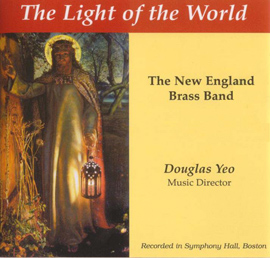 October 26, 2004 - NEW
October 26, 2004 - NEW
Added information about the New England Brass Band's newest CD recording The Light of the World.
I am music director of the New England Brass Band and it is one of my greatest pleasures in music to work with this talented group of adults who make up the
New England Brass Band. Each year, we hold a recording session in Boston's Symhony Hall (the home of the Boston Symphony Orchestra) and record several
tracks for a new CD. We have just released our newest album, "The Light of the World" which features 14 tracks of sacred music. Sacred music is a big part of
the life of brass bands because of the influence of the Salvation Army which appropriated the brass band format shortly after its founding. The result is over 100 years
of superb music written by composers affiliated with the Salvation Army as well as other sacred music written by some of the finest composers in the world.
The disc includes my bass trombone solo performance of Andrew Mackereth's new arrangement "Swing Low" conducted by NEBB Associate Conductor Terry Everson
as well as Terry's exquisite playing of the cornet solo "Be Thou My Vision" arranged by James Curnow. This new page links to the NEBB's website as well as to an
order form so you can order this new disc.
-
October 26, 2004 - UPDATE
Updated the page of Le Monde du Serpent Reviews including a new review
by Trevor Herbert which appeared in the Historic Brass Society Journal.
-
October 26, 2004 - UPDATE
Updated my list of Church Solo Repertoire, revising and adding
some material.
-
October 15, 2004 - UPDATE
Added a new resource, Trombone History: An Annotated Bibliography. One of the most frequently asked
questions I receive is something like this: "I'm doing a report on the history of the trombone. Can you help me?" Since I'm not in the business of writing
people's papers for them, I thought I would provide a resource which would point people to books, periodicals, lexicons, and websites which contain information
about the history of the trombone. This annotated bibliography was put together with the assistance of my friend (trombonist and musicologist) Howard Weiner.
-
October 14, 2004 - UPDATE
Updated the article Pursuing a Career as an Orchestral Musician page with new content and links.
-
October 12, 2004 - UPDATE
Updated schedule page.
-
October 12, 2004 - NEW
Added photos and commenary on several more statues and monuments by Daniel Chester French including
"The Spirit of Life" in Stockbridge, Massachusetts, "Manhattan" and "Brooklyn" outside the Brooklyn Museum, and the Town Drinking Fountain ("Chief Konkapot") in
Lee, Massachusetts.
-
September 15, 2004 - NEW
Added photos and commenary on several statues and monuments by Daniel Chester French including
the Lincoln Memorial and Samuel F. Dupont Memorial in Washington, D.C.
-
August 9, 2004 - COMMENTARY
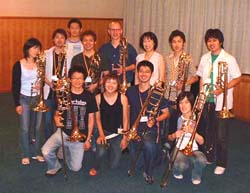 I have just returned home from two weeks in Japan where I was teaching and doing work with YAMAHA on the development of a new bass trombone.
I have just returned home from two weeks in Japan where I was teaching and doing work with YAMAHA on the development of a new bass trombone.
Shown to the left is my class from the 10th Hamamatsu (Japan) International Wind Instrument Academy and Festival. I had participated in the first three of these
annual events in Hamamatsu, which is jointly sponsored by the City of Hamamatsu, the Okura ACT City Hotel and YAMAHA. As in past years, I had a class of seven
students (six bass trombone, 1 tenor trombone) with whom I worked all week. This year's class was the best I'd ever had; the players ranged from students to professional players and the week was a most
enjoyable one. Nozomi Kasano, a fourth year student in college in Nagoya, was selected by audition to represent the class at the student gala concert; she performed
Bozza's "New Orleans." Our accompanist, Maki Asoh, was splendid and I could not have asked to be a part of a better organized and more enjoyable Academy.
Other faculty included Akira Kuwata (Principal trombone of the Yomouri Symphony Orchestra), Mark Gould and Robert Sullivan, trumpets, Tsutomu
Maruyama, horn and Gene Pokorny, tuba (of the Chicago Symphony) - with these players we performed the Ingolf Dahl "Music for Brass Instruments" on the
opening faculty concert.
Later in the week I gave a masterclass at the Dolce Music Shop in Osaka and also gave an interview to the Japanese wind instrument magazine, PIPERS where I
discussed the role historical brasses have played in my musical life.
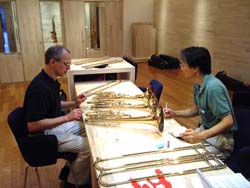 The Academy was a great event, but equally enjoyable was time I spent working with YAMAHA on several projects. YAMAHA trombone designer Yoshihiro
Takahashi (shown at left) and I have been discussing improvements to the YBL-622 bass trombone I currently play. Mr. Takahashi had implemented several key
changes in the horn which I tested and we worked on together while I was at the YAMAHA factory in Hamamatsu. The result will be the release of a new model that
will be a significant upgrade from the 622, containing all of the excellent features of that instrument but with added enhancements about which I am very
excited. This new model will be called the YBL-822G; no release date has been set at this time. I remain very impressed with YAMAHA's commitment to
improve their instruments and have been very pleased to work with them on this new design.
The Academy was a great event, but equally enjoyable was time I spent working with YAMAHA on several projects. YAMAHA trombone designer Yoshihiro
Takahashi (shown at left) and I have been discussing improvements to the YBL-622 bass trombone I currently play. Mr. Takahashi had implemented several key
changes in the horn which I tested and we worked on together while I was at the YAMAHA factory in Hamamatsu. The result will be the release of a new model that
will be a significant upgrade from the 622, containing all of the excellent features of that instrument but with added enhancements about which I am very
excited. This new model will be called the YBL-822G; no release date has been set at this time. I remain very impressed with YAMAHA's commitment to
improve their instruments and have been very pleased to work with them on this new design.
While at the factory I also made a video on how trombones are made. YAMAHA has previously made videos on the making of trumpets and saxophones so I was
pleased when they asked me to help with this project. It was fascinating to go through the factory and observe all of the processes of how trombones are put
together and the video will be released later this year as part of a DVD including all three videos on the making of instruments.
-
July 19, 2004 - NEW and UPDATE
Updated links and some content in my FAQ section including new material in my FAQ on practicing.
-
June 1, 2004 - NEW
Added a new page with photos and information about several instruments for sale.
-
May 20, 2004 - UPDATE and COMMENTARY
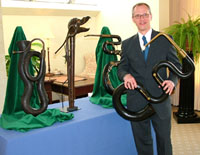 Updated Serpent Photo Gallery page. May 19 was my birthday (actually, it was the
28th anniversary of my 21st birthday) and I got to celebrate it in a very nice way. I was asked to give a presentation on the serpent at the Metropolitan
Museum of Art in New York City. My talk and performance was for the Museum's "AMATI" group, the Friends of Musical Instruments. Having visited the Museum
many times since I was a young boy, it was especially nice to be asked to give a presentation. A larger, better resolution copy of this photo may be found on my
Serpent Photo Gallery Page. I also updated that page with a photo of me at the National Music Museum in Vermillion, South Dakota.
Updated Serpent Photo Gallery page. May 19 was my birthday (actually, it was the
28th anniversary of my 21st birthday) and I got to celebrate it in a very nice way. I was asked to give a presentation on the serpent at the Metropolitan
Museum of Art in New York City. My talk and performance was for the Museum's "AMATI" group, the Friends of Musical Instruments. Having visited the Museum
many times since I was a young boy, it was especially nice to be asked to give a presentation. A larger, better resolution copy of this photo may be found on my
Serpent Photo Gallery Page. I also updated that page with a photo of me at the National Music Museum in Vermillion, South Dakota.
My life with the serpent continues to be one of the most exciting parts of my ongoing musical explorations. I have recently been contracted to play the serpent with
Boston's Handel and Haydn Society during their performances of the Divertimento in B flat ("St. Antoni Chorale") which is attributed to Haydn - these
performances will take place in April 2005 and H&H will use my forthcoming edition of the Divertimento which is being published by Sarastro Music. This is the
same Divertimento I recorded on my new CD, "Le Monde du Serpent." I will also be playing ophicleide in February 2004 when Boston's Chorus Pro Musica performs Hector
Berlioz's "Romeo and Juliet" on period instruments. The adventure continues.
-
May 5, 2004 - UPDATE
Updated Douglas Yeo Biography page and
FAQ on Teachers and Students with some excellent insight from Jacques Barzun.
-
May 2, 2004 - UPDATE
Updated schedule page,
Le Monde du Serpent Reviews page,
and Gazza Ladra Excerpt #2 page
with a new, easier to read pdf download of the excerpt.
-
April 17, 2004 - COMMENTARY
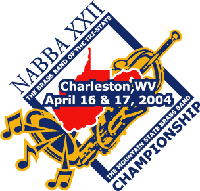 One of the great pleasures of my musical life is to serve as music director of the
New England Brass Band. This 30 piece brass and percussion ensemble meets
for rehearsal weekly in Wilmington, Massachusetts (north of Boston) and presents 6-10 concerts in the Boston area each year. This all-volunteer group
is full of hardworking players who enjoy making music at a high level. Since I became music director of the NEBB in 1998, we have enjoyed an ever increasing
variety of concerts and activities as well as steady growth and mprovement in the musical product we present to our audiences.
One of the great pleasures of my musical life is to serve as music director of the
New England Brass Band. This 30 piece brass and percussion ensemble meets
for rehearsal weekly in Wilmington, Massachusetts (north of Boston) and presents 6-10 concerts in the Boston area each year. This all-volunteer group
is full of hardworking players who enjoy making music at a high level. Since I became music director of the NEBB in 1998, we have enjoyed an ever increasing
variety of concerts and activities as well as steady growth and mprovement in the musical product we present to our audiences.
The North American Brass Band Association sponsors an annual championship contest for brass bands. Contesting
has been part of the brass band movement for nearly 150 years and the NEBB has had the opportunity to go to three of the NABBA contests - 2001 in Washington, D.C.;
2003 in Little Rock, Arkansas; and 2004 in Charleston, West Virginia. Going to these contests has been a huge part of the growth of the NEBB. For us, the important
thing about attending such an event is the interaction we all have with other bands and players as we learn more about our playing in the process. Also, we work
hard to present our 30 minute contest program at the highest level we can, burnishing all of the details of our music to as fine a point as we can make. This
crucible has proven to be a very enjoyable process for the band and today, the NEBB's hard work was rewarded with a banner and a trophy for FIRST PLACE
in the "Challenge" section of the NABBA XXII Championship. What a thrill it was to have the band rewarded for their hard work in this way! I offer my congratulations
once again to the fine members of the NEBB (including principal trombonist Brad Kerns who won 2nd place in the adult low brass technical solo competition, E flat
bass player Mark Fabulich who won 2nd place in the adult low brass slow melody solo competition, and the NEBB percussion section - Dora Kastanas,
Rick Castillo and Stephen Lee for placing 3rd in the adult percussion ensemble competition) for their success at NABBA as we look forward to our continued collaboration together.
I am very proud of all of you!
-
April 12, 2004 - UPDATE
Updated numerous pages including correcting outdated links, correcting a misprint in the
Bach Cello Suite 6 Sarabande,
and updates to the
schedule page.
-
March 17, 2004 - UPDATE
Updated schedule page and Bass Trombone Discography page.
-
March 5, 2004 - UPDATE
Updated schedule page.
-
February 18, 2004 - UPDATE
Updated schedule page and Reviews of "Le Monde du Serpent" page.
-
February 1, 2004 - COMMENTARY
 Today the National Football League's New England Patriots defeated the Carolina Panthers, 32-29 in Super Bowl XXXVIII. As avid fans of the New England
Patriots, my wife and I were thrilled by the outcome of the game - and what a game it was! Both the offense and defense of each team had quite a game, and the
score wasn't settled until Patriots kicker Adam Vinatieri kicked the game winning field goal with 9 seconds left in the game. What made this victory all the more
special to us was the fact that my wife and I were at the Patriots' Gillette Stadium for the final two playoff games which propelled the Patriots into the Super Bowl (games they won against the
Tennessee Titans 17-14 on a day where the temperature at kickoff was 0 degrees farenheit, and against the Indianapolis Colts, 24-14 on a day where it was snowing througout the game!)
and how closely it paralleled the finish of Super Bowl XXXVI in 2002 when the Patriots defeated the St. Louis Rams, 20-17. That game was also
decided with a Vinatieri field goal - with only 6 seconds left in the game. I attended Super Bowl XXXVI in New Orleans and it remains one of the most potent
experiences of my life. As a member of the Boston Pops Orchestra, I played in the pre-game show to that game and then enjoyed the game courtesy of a ticket given to
me (and other members of the orchestra) by Patriots owner Robert Kraft, a man who surely is one of the greatest owners of a sports team in the world. At the time
of Super Bowl XXXVI I kept a daily diary of the preparations of the Boston Pops Orchestra as well as my own feelings at that thrilling time. For those interested,
that diary (with many color photos) is still available for viewing on my website; see
The New England Patriots and the Boston Pops: A Super Bowl XXXVI Diary.
Today the National Football League's New England Patriots defeated the Carolina Panthers, 32-29 in Super Bowl XXXVIII. As avid fans of the New England
Patriots, my wife and I were thrilled by the outcome of the game - and what a game it was! Both the offense and defense of each team had quite a game, and the
score wasn't settled until Patriots kicker Adam Vinatieri kicked the game winning field goal with 9 seconds left in the game. What made this victory all the more
special to us was the fact that my wife and I were at the Patriots' Gillette Stadium for the final two playoff games which propelled the Patriots into the Super Bowl (games they won against the
Tennessee Titans 17-14 on a day where the temperature at kickoff was 0 degrees farenheit, and against the Indianapolis Colts, 24-14 on a day where it was snowing througout the game!)
and how closely it paralleled the finish of Super Bowl XXXVI in 2002 when the Patriots defeated the St. Louis Rams, 20-17. That game was also
decided with a Vinatieri field goal - with only 6 seconds left in the game. I attended Super Bowl XXXVI in New Orleans and it remains one of the most potent
experiences of my life. As a member of the Boston Pops Orchestra, I played in the pre-game show to that game and then enjoyed the game courtesy of a ticket given to
me (and other members of the orchestra) by Patriots owner Robert Kraft, a man who surely is one of the greatest owners of a sports team in the world. At the time
of Super Bowl XXXVI I kept a daily diary of the preparations of the Boston Pops Orchestra as well as my own feelings at that thrilling time. For those interested,
that diary (with many color photos) is still available for viewing on my website; see
The New England Patriots and the Boston Pops: A Super Bowl XXXVI Diary.
-
January 22, 2004 - UPDATE
Updated other links page.
-
December 26, 2003 - UPDATE
Updated schedule page.
-
December 11, 2003, 2003 - COMMENTARY
Today is Hector Berlioz's bicentennial - he was born on December 11, 1803. The Canadian Broadcast Corporation's Radio 2 is devoting the entire day to music
of Berlioz as well as interviews with people who are speaking about Berlioz and his world. At some point during the day, I will be heard on the program speaking
about Berlioz's use of brass instruments, in particular the serpent and ophicleide. You can hear this program on the internet by going to the
CBC Radio 2 'Berlioz Fantastique' page where the program can be heard via RealAudio, Quicktime or
Windows Media Player.
Also, I have just gotten word that
WGBH Radio
WGBH Radio in Boston would like to record and broadcast the New England Brass Band concert that will take place at the Andover
Free Christian Church (Andover, Massachusetts) on Saturday, December 20. This is an exciting thing for the band and we are delighted that WGBH will be at our
concert to capture the unique sound of the New England Brass Band. Selections from the concert will be broadcast during the day on December 24. WGBH radio can also be heard live on the internet through the
WGBH Radio website.
-
December 11, 2003 - UPDATE
Updated schedule page.
-
December 3, 2003 - NEW
Added a new page with information about the new Douglas Yeo "Le Monde du Serpent" Floaty Pen. This whimsical
pen was made to coincide with my new CD release, Le Monde du Serpent, and
contains miniature photographs of historical brass instruments, Gregorian chant and much more.
-
November 25, 2003 - UPDATE
Updated the Till Eulenspiegel Excerpt 1 page on my Bass Trombonist's Orchestral Handbook
with a discussion of a misprint which appears in most editions of the part and the implications of playing the correct note when taking an audition.
-
November 26, 2003 - UPDATE
Updated trombone humor page to include a wild image of an instrument called the "loophonium"
which recently sold at auction at Southeby's in London.
-
November 26, 2003 -UPDATE
Added a review of my new CD, "Le Monde du Serpent," which appeared in the OnLine Trombone Journal, to my page of
Reviews of "Le Monde du Serpent" .
-
November 11, 2003 - UPDATE
Updated trombone humor page to include a wonderful image recently sent to me of the Lincoln
Memorial in Washington, D.C. which shows Abraham Lincoln to have played our favorite instrument.
-
November 11, 2003 - UPDATE
Updated schedule page to include a photo of the
New England Brass Band.
-
November 10, 2003 - UPDATE
Updated schedule page.
-
November 9, 2003 -UPDATE
Edited and added new material to my
FAQ on copyright law and "ripping" CDs .
-
November 8, 2003 -NEW
Added a new page of information about my new CD, "Le Monde du Serpent" which contains
Reviews of "Le Monde du Serpent" .
-
November 6, 2003 - NEW
Added two new articles with photos and commentary on American artist Daniel Chester French's sculptures
The Slocum Memorial and
The Clark Memorial,
situated in Forest Hills Cemetery near Boston, Massachusetts.
-
November 6, 2003 - UPDATE
Added several paragraphs to my FAQ Number 22, Travelling on an airplane with your trombone
including commentary about hard shell golf bag cases and a link to SKB, a manufacturer of such cases.
-
November 5, 2003 -NEW
Added a new article with photos and commentary on American artist Daniel Chester French's sculpture
The George Robert White Memorial ('Casting Bread Upon the Waters')
which depicts a stunning angel, situated in the Public Garden in Boston, Massachusetts.
-
November 5, 2003- UPDATE
Added a link on my page devoted to Daniel Chester French's
sculpture Alma Mater to an article
in "Columbia News" which discusses the restoration of Alma Mater
which is situated on the campus of Columbia University, New York City, New York.
-
November 5, 2003 - COMMENTARY
This afternoon I went to the studios of radio station WBUR in Boston (Boston University's National Public Radio station) and was interviewed by
the Canadian Broadcast Corporation for a program they will be running all day on Hector Berlioz's birthday, December 11, 2003 (his bicentennial). The program
will air from 8:00 AM - 10 :00 PM on CBC Radio 2 and may also be heard on the web (Realplayer, Quicktime or Windows Media Player) via the
CBC Radio 2 website. I was interviewed about Berlioz's use of the serpent and the ophicleide, and the
evolution of bass brass instruments in Berlioz's time. The program will be hosted by the Canadian tenor, Ben Heppner, and will include interviews, recordings, and
live performances. After I gave my interview segment, former Boston Symphony principal trumpeter Roger Voisin stepped into the studio to talk about his experience
playing and recording music of Berlioz with Charles Munch who was arguably one of the great Berlioz interpreters of the 20th century.
-
November 2, 2003 - NEW
Added FAQ Number 22, Travelling on an airplane with your trombone
which includes suggestions and photos giving strategies on how to get your trombone safely through a trip by air either as a carry on bag or as checked luggage.
-
November 2, 2003 - UPDATE
Added new photos of Christopher Monk to Le Monde du Serpent Program Notes page.
These may be found in the program notes to the "Allegretto" from Beethoven's "Symphony 7."
-
November 1, 2003 - NEW
Added free mp3 files of selected tracks from my CD "Le Monde du Serpent" which may
accessed on the Le Monde du Serpent page.
-
November 1, 2003 - UPDATE
Updated schedule page.